The Re-Birth of the Second Plane Child
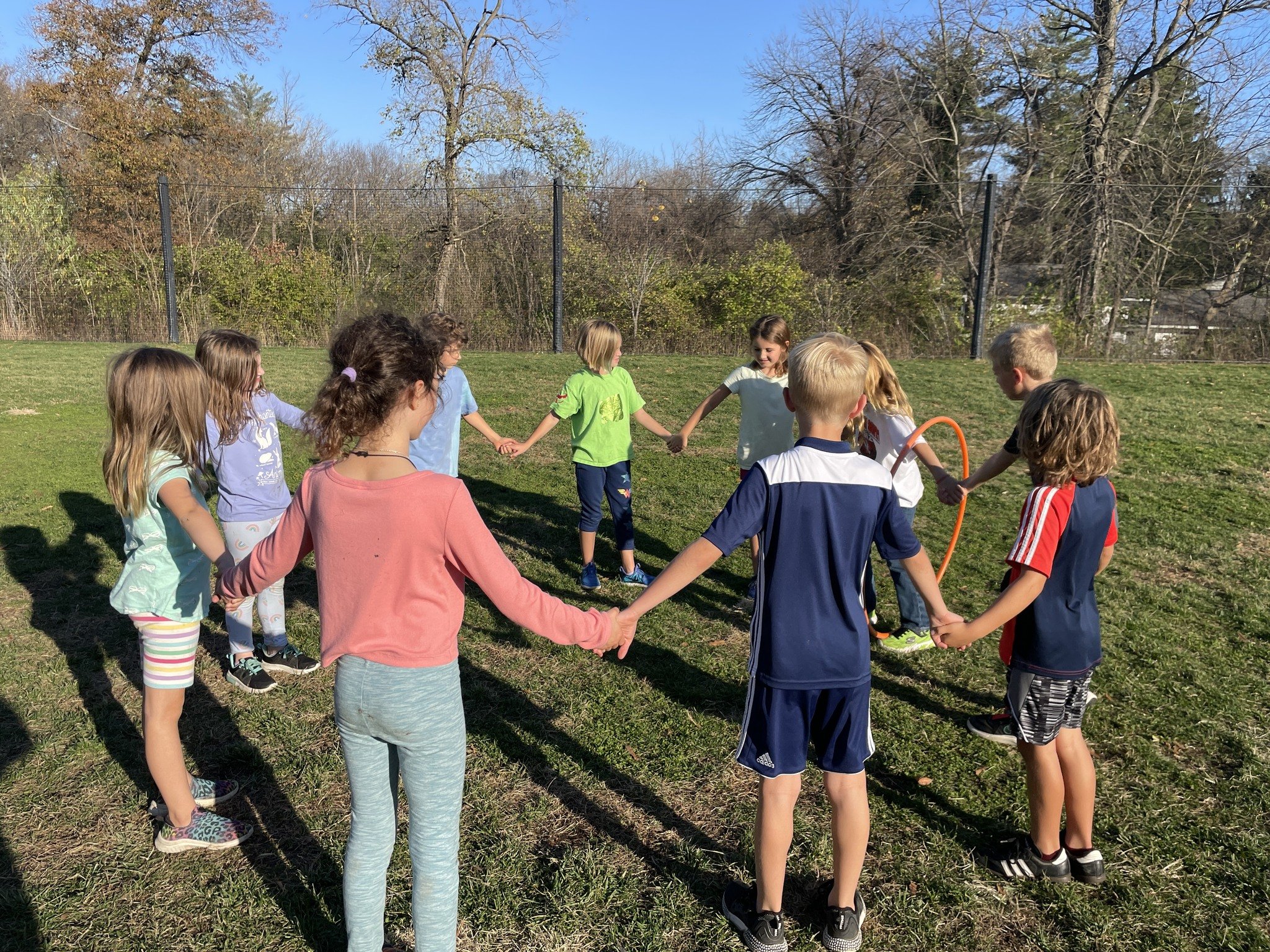 The start of the academic year is always a joyful, exciting time with the reunion of old friends and welcoming new ones. Many children returned to their familiar classroom environments and communities of children and guides, while other students made the transition to their brand new community. Today we’d like to discuss the transition between the Children’s House environments (3-6 years old) to the Elementary (6-12 years old). This is the most significant transition that happens here at Villa di Maria Montessori, because it encompasses a shift from the First Plane of Development to the Second Plane. Dr. Maria Montessori used this framework of the Four Planes of Development to describe the journey each child passes through from birth to adulthood. Read more about Dr. Montessori’s Four Planes on this past blog post.
The start of the academic year is always a joyful, exciting time with the reunion of old friends and welcoming new ones. Many children returned to their familiar classroom environments and communities of children and guides, while other students made the transition to their brand new community. Today we’d like to discuss the transition between the Children’s House environments (3-6 years old) to the Elementary (6-12 years old). This is the most significant transition that happens here at Villa di Maria Montessori, because it encompasses a shift from the First Plane of Development to the Second Plane. Dr. Maria Montessori used this framework of the Four Planes of Development to describe the journey each child passes through from birth to adulthood. Read more about Dr. Montessori’s Four Planes on this past blog post.  As parents, witnessing this shift in characteristics of their child from the First to Second Plane can be a bit surprising and often results in the need for readjustments in the household/family life. Dr. Montessori believed this transition was so momentous that she called it a re-birth. Our annual Montessori 202 presentation was born out of the need to help parents successfully navigate this important transition. Our guides do a tremendous job presenting crucial information during this yearly Parent Talk and we’d like to share some important pieces for those of you that are looking to the future or wanting (needing!) a refresher. If you know what’s ahead, it’s easier to adapt and embrace the changes that emerge.
As parents, witnessing this shift in characteristics of their child from the First to Second Plane can be a bit surprising and often results in the need for readjustments in the household/family life. Dr. Montessori believed this transition was so momentous that she called it a re-birth. Our annual Montessori 202 presentation was born out of the need to help parents successfully navigate this important transition. Our guides do a tremendous job presenting crucial information during this yearly Parent Talk and we’d like to share some important pieces for those of you that are looking to the future or wanting (needing!) a refresher. If you know what’s ahead, it’s easier to adapt and embrace the changes that emerge. 
Second Plane Characteristics
Children begin to transition to the Second Plane of Development around the age of six years old. It doesn’t magically happen on their sixth birthday or at the end of their Culminating year in the Children’s House. Gradually you will begin to notice some of these characteristics revealing themselves in your child as the transition to elementary grows near. 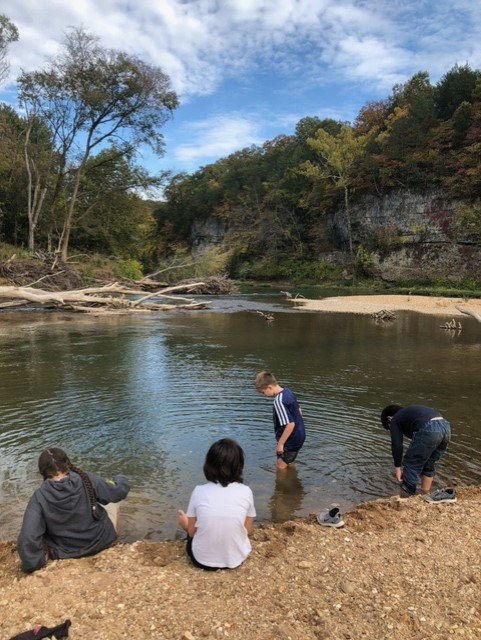
Fearless and Tough
The second plane child is strong physically. The first plane child tends to be more susceptible to illness, as does the adolescent (12-18 years old). The elementary child is more daring and adventurous and doesn’t want a fuss made over an injury, like they might have when they were younger. Within safe limits, it is beneficial to allow the child to take these bold leaps and bounds in order to build their confidence. 
Messy
The elementary child tends to be a bit messy and untidy, generally speaking. They no longer have the urge to order their external environment because they’ve internalized that order. They are now focused on ordering their mind. You might notice this trend affecting their personal hygiene as well. They might lack awareness of the dirt on their hands or the changes in their body odor, so they need gentle and firm encouragement to continue regular handwashing and bathing or showering. Please see more ideas further down in this post for assistance with household cleaning and organization. 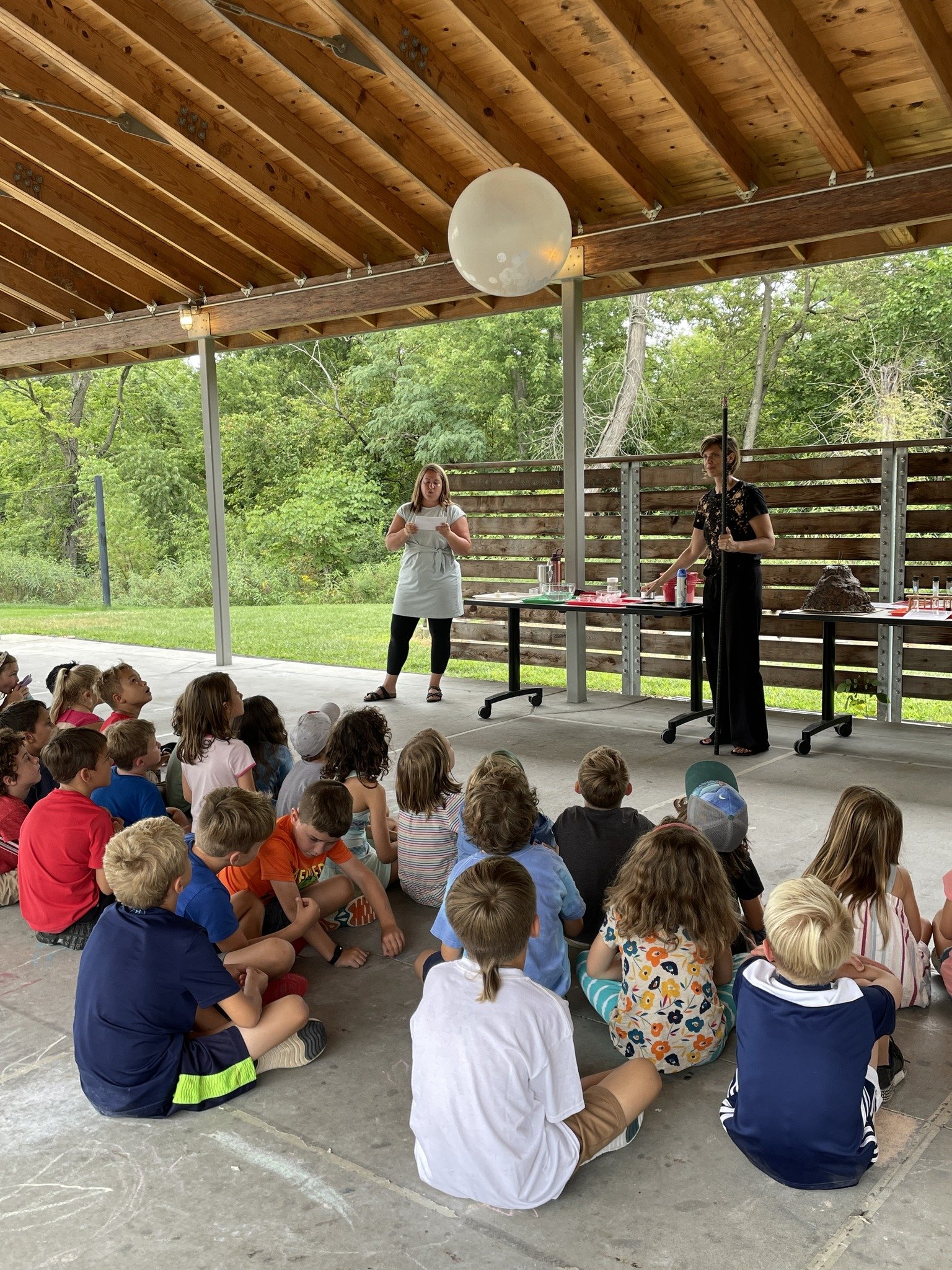
“Why?”
Dr. Montessori spoke of these years between the age of six and twelve years as the most intellectual of a person’s life. Their brain functions differently than the way it functioned throughout the first plane, where they had the power of the Absorbent Mind. Now entering the phase of the rational mind, they want to ask ALL THE QUESTIONS about the world around them, and well beyond. Why do the birds migrate? Why is the sun so hot? Why does my family do things differently than other families? We want to invite these questions and explore together to find the answers. Guides seek to connect students with resources (books, safe internet websites, experts in the field) to promote their independence in finding answers in the future. 
Socialization
Friendships become more important to the child at this stage of their development. In the First Plane, the child was mainly focused on self-construction (i.e. independent movement, development of language, eating, putting on shoes, etc.), and now, in the second plane, the child must begin to take their place in society at large, well beyond the home and the classroom. We encourage and support the “Going Out” in our elementary community because the classroom is no longer sufficient to satisfy the needs of this intellectual extrovert. To learn more about “Going Out”, check out this past blog post. Parents can support the expression of this characteristic by providing opportunities for the child to accompany them into society (i.e. taking the lead in paying at the cash register or navigating directions to the store). 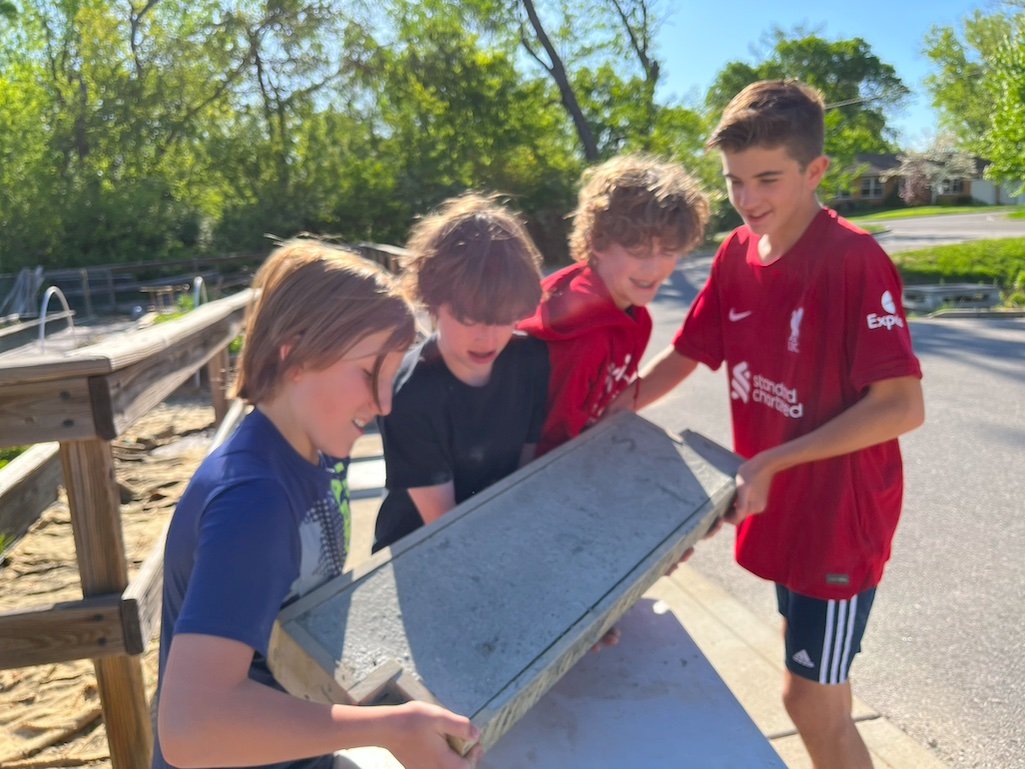
Justice
During these years, the children develop a strong awareness of morality and justice. Their conscience emerges more clearly as they explore their sense of right and wrong. This might express itself as tattling or reporting as they seek to understand what is acceptable and what is not. Guides in the classroom notice this particularly around the ages of 6 ½ - 8 years old. Initially, the intent may not be to get others in trouble, but merely to know if the guide will accept this behavior. Guides respond in a way that helps the child begin to set their own moral compass, confirming whether the behavior is right or wrong, but not necessarily intervening to stop the behavior right away (unless safety is a concern). In this way, the guide addresses the moral need of the child, without reinforcing a pattern that could develop.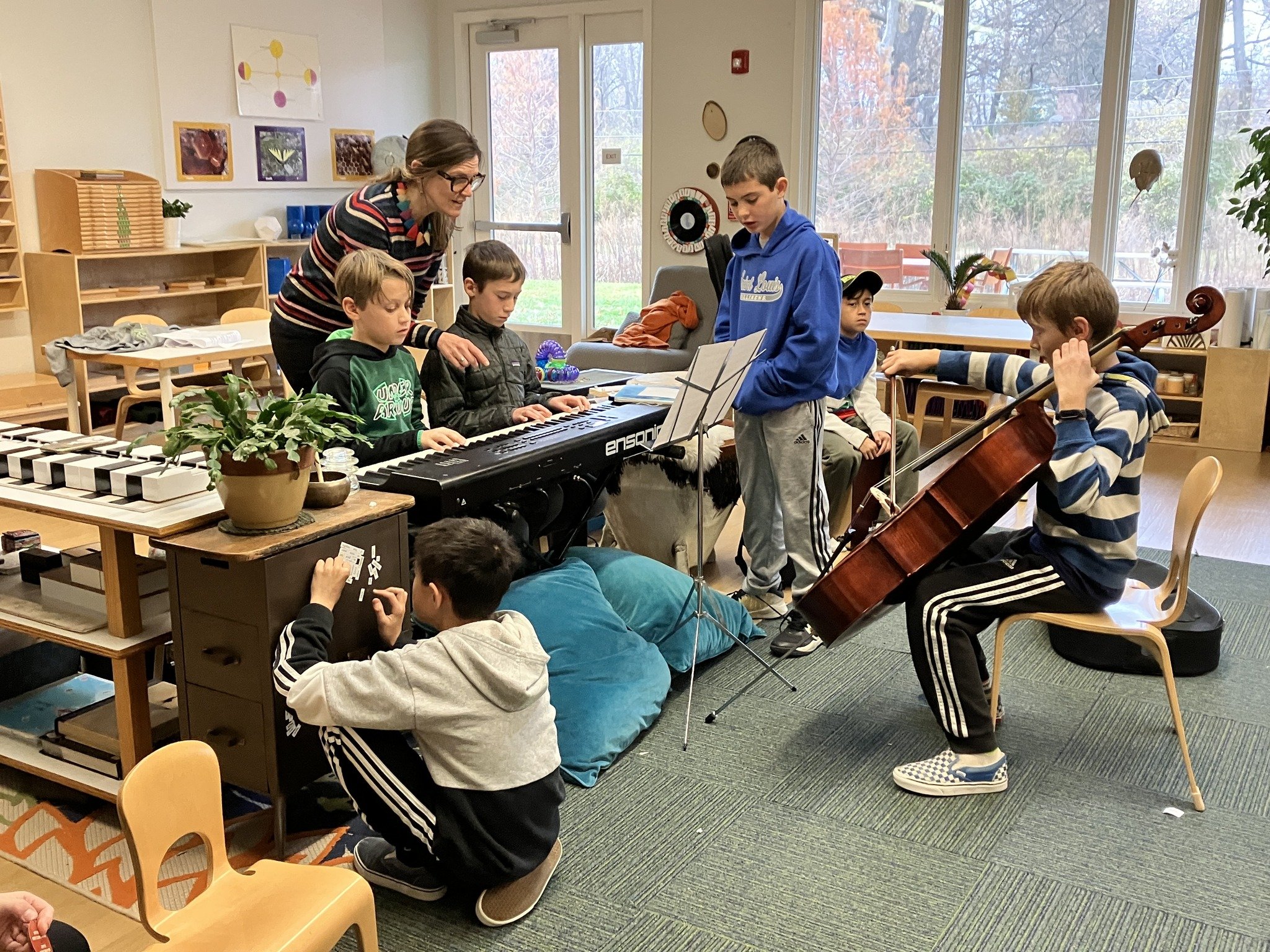
Hero Worship
Along with the sensitivity towards morality, the elementary child seeks out heroes; admirable people to look up to. Guides and parents can help direct the child toward positive heroes and role models through books, stories and relevant current events. We want the children to recognize the true heroes of this world, those who sacrifice for others and work to make our world a better place. 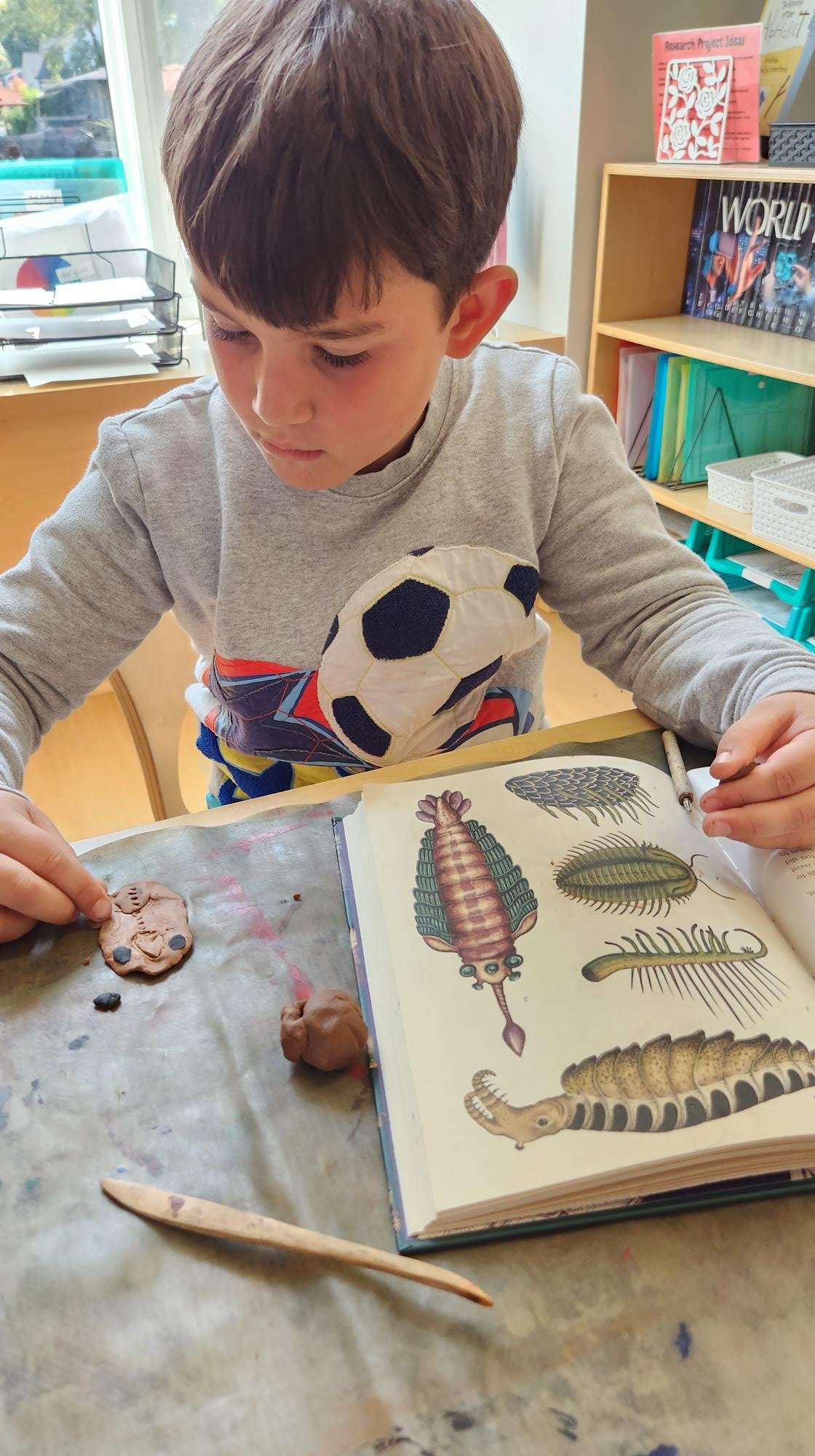
How to Support your Second Plane Child
What are the ways you can assist your child smoothly through this transition? First of all, simply being aware of these characteristics will help you recognize that this shift is to be expected and embraced as your child continues on their developmental path. In the area of cleanliness, though they won’t naturally care to keep things as tidy and organized, it is still important to have structure and expectations in this area. In the elementary classroom, we give the child freedom to explore their work and to create expressively, but once the work is finished or the work period has ended, we expect them to tidy their spaces, clean the materials and return them to their space ready for the next child to use. Likewise, you might decide at home that there are certain times when projects must be cleaned up or stored away. Perhaps consider implemenmting a cleaning routine before bed or helping tidy the kitchen right after dinner. Elementary age children need assistance with these boundaries to maintain external order because this does not come as naturally for them in this season of their life. Because children in the Second Plane are motivated socially, doing chores together might help them complete a task. Deciding expectations together, as a family, ahead of time will be important as well. Their keen sense of justice will rest a bit if they have some choices in which chores and responsibilities they agree to do. 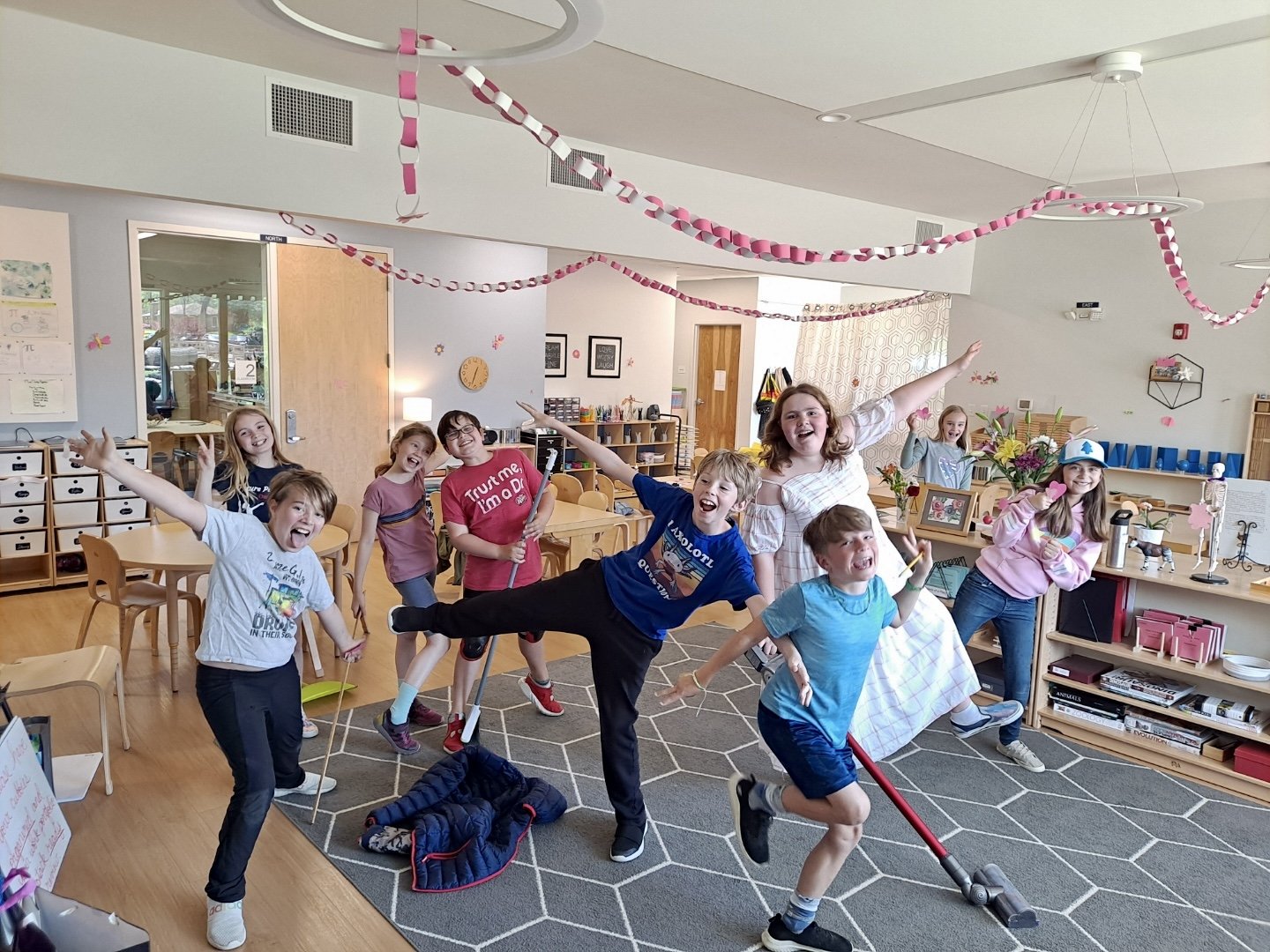 Finally, you are supporting your Second Plane child simply by having them at an authentic Montessori school! The elementary environments (including the guides) are specifically tailored to meet the needs of this age group so that they can utilize the characteristics of this season to the utmost. The energies of this deeply intellectual and social period needs to be harnessed, guided and encouraged. What better place to explore all their deep questions about the universe than in the rich, engaging Montessori environment? Because the elementary classroom addresses the social, emotional, and intellectual needs of our Second Plane children, they are able to thrive and reach their potential, becoming their own heroes, and perhaps someday to save the world.
Finally, you are supporting your Second Plane child simply by having them at an authentic Montessori school! The elementary environments (including the guides) are specifically tailored to meet the needs of this age group so that they can utilize the characteristics of this season to the utmost. The energies of this deeply intellectual and social period needs to be harnessed, guided and encouraged. What better place to explore all their deep questions about the universe than in the rich, engaging Montessori environment? Because the elementary classroom addresses the social, emotional, and intellectual needs of our Second Plane children, they are able to thrive and reach their potential, becoming their own heroes, and perhaps someday to save the world. 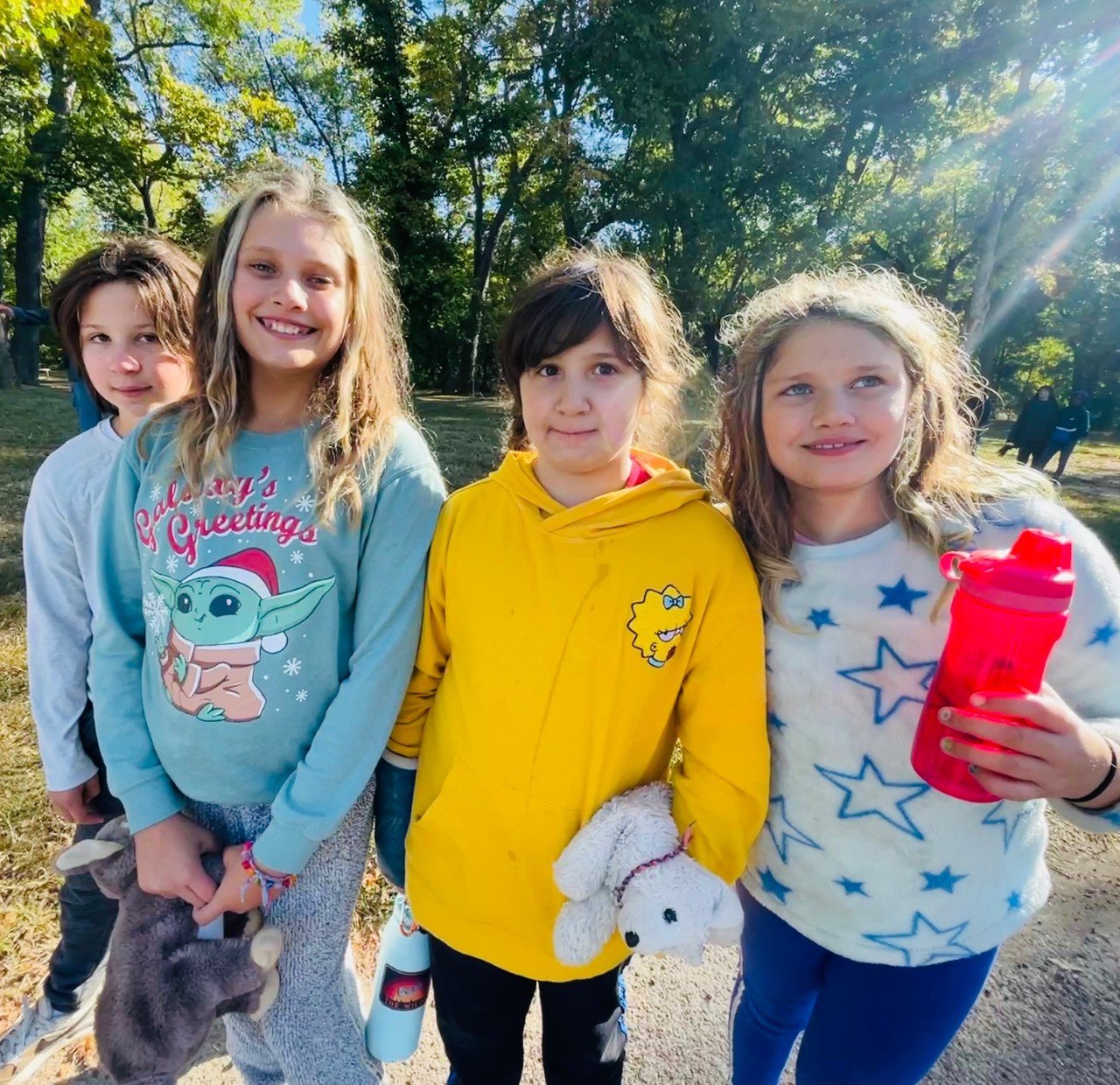


 We Montessorians sometimes use terminology that’s unfamiliar to folks more accustomed to a traditional school model, and this can lead to a bit of a mystification around the philosophy. It can even lead to the notion that Montessori schools are out of reach for the general population—that the methods in a Montessori school are too specialized, too… strange.In fact, the concepts of Montessori, and the vocabulary we use, were borne from Dr. Maria Montessori’s education, research, and maybe most importantly, her observations of real children at work. In other words, Montessori concepts and vocabulary are rooted in the natural processes of child development—concepts are very familiar, even intuitive, to anyone who lives or works with children. In our Montessori 101 series, we’ll demystify and explore Montessori terminology. This week, we’ll take a look at the benefits the Montessori multi-age classroom offers.
We Montessorians sometimes use terminology that’s unfamiliar to folks more accustomed to a traditional school model, and this can lead to a bit of a mystification around the philosophy. It can even lead to the notion that Montessori schools are out of reach for the general population—that the methods in a Montessori school are too specialized, too… strange.In fact, the concepts of Montessori, and the vocabulary we use, were borne from Dr. Maria Montessori’s education, research, and maybe most importantly, her observations of real children at work. In other words, Montessori concepts and vocabulary are rooted in the natural processes of child development—concepts are very familiar, even intuitive, to anyone who lives or works with children. In our Montessori 101 series, we’ll demystify and explore Montessori terminology. This week, we’ll take a look at the benefits the Montessori multi-age classroom offers. In a Montessori school, you will not find separate classrooms for preschool, Kindergarten, 1st grade, etc., as you might in a traditional school. Instead, each Montessori classroom environment serves children in a three-year range of ages. Why do we do this? Isn’t it confusing to have multiple grades and ages in one classroom? How does the guide teach all the right lessons to the right students?The fundamental principle behind the mixed-age environment is this: Montessori places children into environments based on their developmental stage. Dr. Montessori’s research suggests that children go through multiple-year stages of development from birth to adulthood, called “the four planes of development.” (Stay tuned for a blog post about the four planes!). In each plane, there are specific emotional, physical, social, and intellectual milestones, as well as specific emotional, physical, social, and intellectual needs. Montessori environments are specialized to foster those milestones and serve those needs.
In a Montessori school, you will not find separate classrooms for preschool, Kindergarten, 1st grade, etc., as you might in a traditional school. Instead, each Montessori classroom environment serves children in a three-year range of ages. Why do we do this? Isn’t it confusing to have multiple grades and ages in one classroom? How does the guide teach all the right lessons to the right students?The fundamental principle behind the mixed-age environment is this: Montessori places children into environments based on their developmental stage. Dr. Montessori’s research suggests that children go through multiple-year stages of development from birth to adulthood, called “the four planes of development.” (Stay tuned for a blog post about the four planes!). In each plane, there are specific emotional, physical, social, and intellectual milestones, as well as specific emotional, physical, social, and intellectual needs. Montessori environments are specialized to foster those milestones and serve those needs. At Villa di Maria, you’ll find separate environments designed to serve children 14 months through 3 years—the Young Children’s Community; 3 years through 6 years—the Children’s House; 6 through 9—Lower Elementary; and 9 through 12—Upper Elementary.So, back to those questions at the top: Isn’t it confusing to have multiple grades ages in one classroom? Put simply… no. And in fact, we believe it makes more sense than the preschool – 12 system of traditional schooling. Nowhere else in life are we placed exclusively with others our exact age. Dr. Montessori believed the classroom should be as accurate a reflection of the child’s culture as possible—Montessori education prepares children for life. And the age-specific environment just doesn’t happen in the real world. In the mixed-age environment, children learn to work alongside, and collaborate with their older and younger peers.
At Villa di Maria, you’ll find separate environments designed to serve children 14 months through 3 years—the Young Children’s Community; 3 years through 6 years—the Children’s House; 6 through 9—Lower Elementary; and 9 through 12—Upper Elementary.So, back to those questions at the top: Isn’t it confusing to have multiple grades ages in one classroom? Put simply… no. And in fact, we believe it makes more sense than the preschool – 12 system of traditional schooling. Nowhere else in life are we placed exclusively with others our exact age. Dr. Montessori believed the classroom should be as accurate a reflection of the child’s culture as possible—Montessori education prepares children for life. And the age-specific environment just doesn’t happen in the real world. In the mixed-age environment, children learn to work alongside, and collaborate with their older and younger peers. In fact, the mixed-age classroom allows children to take on different roles in relation to their peers over the course of their time in each environment. On the younger end of the age range, children are careful observers of their older peers, gaining inspiration and motivation from their work. As they move into their final year in their environment, their culminating year, children take on leadership roles. With two years of experience settling into the routines and values of their classroom, the older students are ready to model positive behavior and inspire the younger children with their beautiful and challenging work. The older children, themselves, develop patience and compassion as they assist and encourage their younger peers in areas of struggle.
In fact, the mixed-age classroom allows children to take on different roles in relation to their peers over the course of their time in each environment. On the younger end of the age range, children are careful observers of their older peers, gaining inspiration and motivation from their work. As they move into their final year in their environment, their culminating year, children take on leadership roles. With two years of experience settling into the routines and values of their classroom, the older students are ready to model positive behavior and inspire the younger children with their beautiful and challenging work. The older children, themselves, develop patience and compassion as they assist and encourage their younger peers in areas of struggle. But what about grade-level work—how does the guide teach all the right lessons to the right students? The mixed-age classroom supports each child’s individual learning pace within their plane of development. Children have the opportunity to work with older students in some areas and younger students in other areas. For example, if a child is struggling to master subtraction, giving a lesson to a younger student could help. Teaching someone else how to do something cements that learning in their own brain. When they are ready for more challenging math work, they can be paired with older students for a challenge. The diversity of ages in the classroom promotes the value of unique learning styles and timelines. We all have areas of strength and weakness. We each progress to understanding and mastery in our own time.
But what about grade-level work—how does the guide teach all the right lessons to the right students? The mixed-age classroom supports each child’s individual learning pace within their plane of development. Children have the opportunity to work with older students in some areas and younger students in other areas. For example, if a child is struggling to master subtraction, giving a lesson to a younger student could help. Teaching someone else how to do something cements that learning in their own brain. When they are ready for more challenging math work, they can be paired with older students for a challenge. The diversity of ages in the classroom promotes the value of unique learning styles and timelines. We all have areas of strength and weakness. We each progress to understanding and mastery in our own time. Additionally, the multi-age classroom allows the child to develop leadership skills in his culminating year. The older children model positive behavior, as they’ve had two years to settle into the routines and values of that classroom. They also inspire the younger children with their beautiful and challenging work projects. The older children develop patience and compassion as they assist and encourage the younger in areas of struggle.
Additionally, the multi-age classroom allows the child to develop leadership skills in his culminating year. The older children model positive behavior, as they’ve had two years to settle into the routines and values of that classroom. They also inspire the younger children with their beautiful and challenging work projects. The older children develop patience and compassion as they assist and encourage the younger in areas of struggle. What all child development research tells us is that, while there are certainly milestones that will be met for most children at certain stages, these stages are not neatly divided into one-year segments. There is no age-prompted switch that automatically turns on for reading or algebra. Each typically developing child in a learning environment will hit their milestones within a range of ages. And this is exactly what the mixed-age environment offers.
What all child development research tells us is that, while there are certainly milestones that will be met for most children at certain stages, these stages are not neatly divided into one-year segments. There is no age-prompted switch that automatically turns on for reading or algebra. Each typically developing child in a learning environment will hit their milestones within a range of ages. And this is exactly what the mixed-age environment offers.
 We Montessorians sometimes use terminology that’s unfamiliar to folks more accustomed to a traditional school model, and this can lead to a bit of a mystification around the philosophy. It can even lead to the notion that Montessori schools are out of reach for the general population—that the methods in a Montessori school are too specialized, too… strange.
We Montessorians sometimes use terminology that’s unfamiliar to folks more accustomed to a traditional school model, and this can lead to a bit of a mystification around the philosophy. It can even lead to the notion that Montessori schools are out of reach for the general population—that the methods in a Montessori school are too specialized, too… strange. In fact, the concepts of Montessori, and the vocabulary we use to describe those concepts, were borne from Dr. Maria Montessori’s education, research, and maybe most importantly, her observations of real children at work. In other words, Montessori concepts and vocabulary are rooted in the natural processes of child development, and these concepts are very familiar, even intuitive, to anyone who lives or works with children. In our Montessori 101 series, we’ll demystify Montessori vocabulary and explore the concepts that inform it. This week, we’ll unpack what we mean by an “environment,” as opposed to a “classroom”.
In fact, the concepts of Montessori, and the vocabulary we use to describe those concepts, were borne from Dr. Maria Montessori’s education, research, and maybe most importantly, her observations of real children at work. In other words, Montessori concepts and vocabulary are rooted in the natural processes of child development, and these concepts are very familiar, even intuitive, to anyone who lives or works with children. In our Montessori 101 series, we’ll demystify Montessori vocabulary and explore the concepts that inform it. This week, we’ll unpack what we mean by an “environment,” as opposed to a “classroom”. Montessori often compares human development to the growth of a plant. The plant has everything it needs to grow within itself; it only requires the proper environment (soil, water, sunlight, warmth). Similarly, humans require certain environmental factors to mature and flourish. We know infants require consistent positive interaction with caregivers in order to form attachment and one day function in society. Babies need freedom of movement in order to learn to walk. They need to hear their native language to be able to develop language themselves. Amazingly, typically developing little humans acquire the abilities to walk and speak without any formal instruction! Movement and language develop organically in an environment rich with stimuli and interaction.
Montessori often compares human development to the growth of a plant. The plant has everything it needs to grow within itself; it only requires the proper environment (soil, water, sunlight, warmth). Similarly, humans require certain environmental factors to mature and flourish. We know infants require consistent positive interaction with caregivers in order to form attachment and one day function in society. Babies need freedom of movement in order to learn to walk. They need to hear their native language to be able to develop language themselves. Amazingly, typically developing little humans acquire the abilities to walk and speak without any formal instruction! Movement and language develop organically in an environment rich with stimuli and interaction.
 As children develop, they require a developing set of stimuli to aid them toward their full potential. Dr. Montessori observed that children pass through four stages of development from birth to adulthood. She called these stages, “The Four Planes of Development.” An in-depth look into the four planes of development is coming to the blog very soon—for now, the takeaway is this: the characteristics of children change from plane to plane; and each plane of development requires a particular environment and trained adult suited to the needs of that plane.
As children develop, they require a developing set of stimuli to aid them toward their full potential. Dr. Montessori observed that children pass through four stages of development from birth to adulthood. She called these stages, “The Four Planes of Development.” An in-depth look into the four planes of development is coming to the blog very soon—for now, the takeaway is this: the characteristics of children change from plane to plane; and each plane of development requires a particular environment and trained adult suited to the needs of that plane. In a Montessori school, classrooms (yes, we still call it a “classroom” sometimes!) are designed and thoughtfully prepared along the lines of the planes and sub-planes of development. Montessori divides the first plane into a sub-plane of zero-to-three years old and three-to-six years old—these are the Young Children’s Community (YCC) and the Children’s House. The YCC environment is designed to facilitate the natural work of the very young child: the construction of physical and biological independence. The YCC assists children as they learn to walk, talk, and perform activities independently. From ages to three through six, the Children’s House environment continues to foster the independence of the first-plane child.
In a Montessori school, classrooms (yes, we still call it a “classroom” sometimes!) are designed and thoughtfully prepared along the lines of the planes and sub-planes of development. Montessori divides the first plane into a sub-plane of zero-to-three years old and three-to-six years old—these are the Young Children’s Community (YCC) and the Children’s House. The YCC environment is designed to facilitate the natural work of the very young child: the construction of physical and biological independence. The YCC assists children as they learn to walk, talk, and perform activities independently. From ages to three through six, the Children’s House environment continues to foster the independence of the first-plane child. In the second plane of development, the sub-planes break down into six-to-nine years old and nine-to-twelve years old—Lower Elementary and Upper Elementary. In these environments children are offered materials and lessons to develop mental independence and a reasoning mind. The elementary environments also offer social opportunities as children become motivated to work and spend time with others. For this reason, the Montessori elementary environment provides larger work tables to accommodate groups of children. The elementary guide presents lessons to groups of children because of the intense drive to work with peers.
In the second plane of development, the sub-planes break down into six-to-nine years old and nine-to-twelve years old—Lower Elementary and Upper Elementary. In these environments children are offered materials and lessons to develop mental independence and a reasoning mind. The elementary environments also offer social opportunities as children become motivated to work and spend time with others. For this reason, the Montessori elementary environment provides larger work tables to accommodate groups of children. The elementary guide presents lessons to groups of children because of the intense drive to work with peers. A “classroom” connotes a room in which a class is held, where information is imparted from one person to another. Montessori doesn’t see education that way. In a Montessori school, we see the innate power children have to form themselves, as flowers do, given the appropriate surroundings—surroundings that meet the needs of the particular developmental stage. As Dr. Montessori said,
A “classroom” connotes a room in which a class is held, where information is imparted from one person to another. Montessori doesn’t see education that way. In a Montessori school, we see the innate power children have to form themselves, as flowers do, given the appropriate surroundings—surroundings that meet the needs of the particular developmental stage. As Dr. Montessori said,
 By calling the classroom an “environment,” Montessorians seek to give agency to the child in their process of formation. We see the trained adult as an important part of the environment, who guides the child in his journey toward becoming a fully formed adult.
By calling the classroom an “environment,” Montessorians seek to give agency to the child in their process of formation. We see the trained adult as an important part of the environment, who guides the child in his journey toward becoming a fully formed adult.


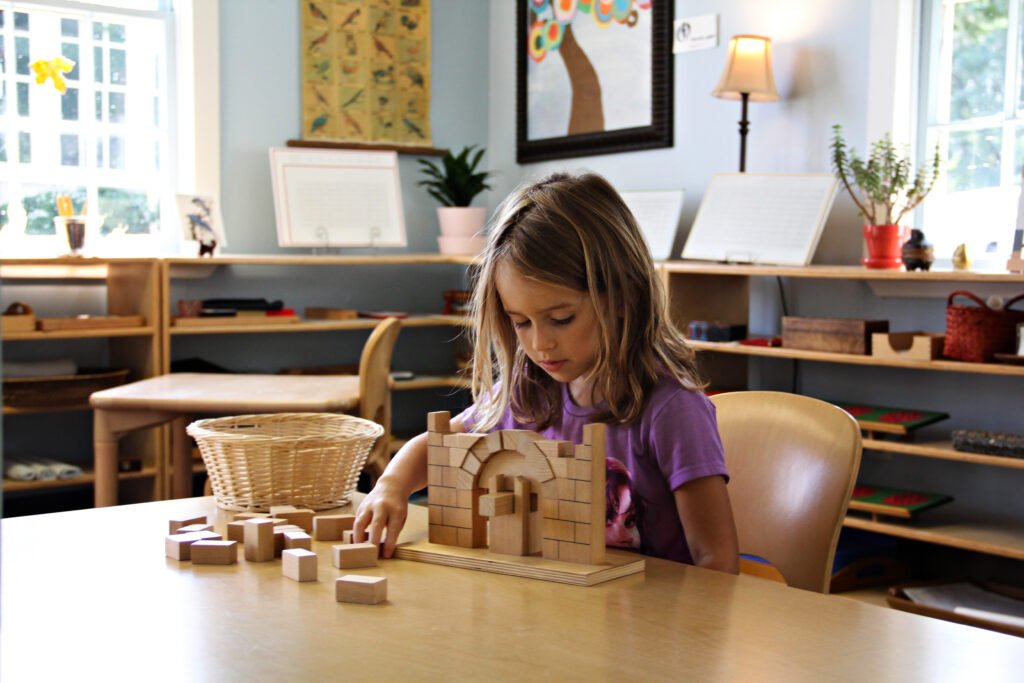
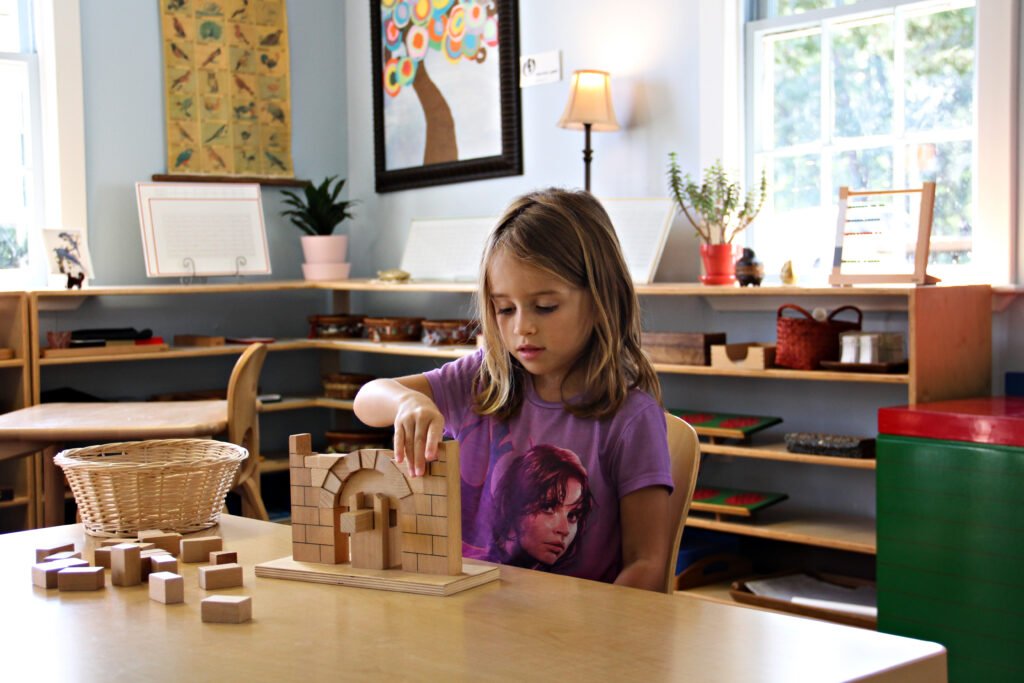
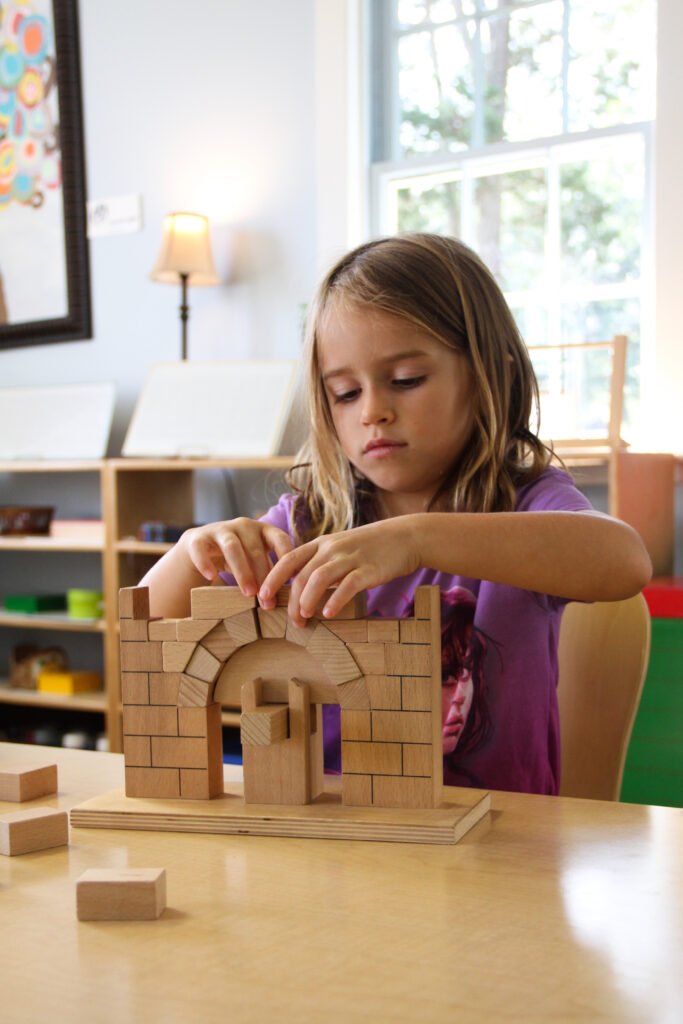
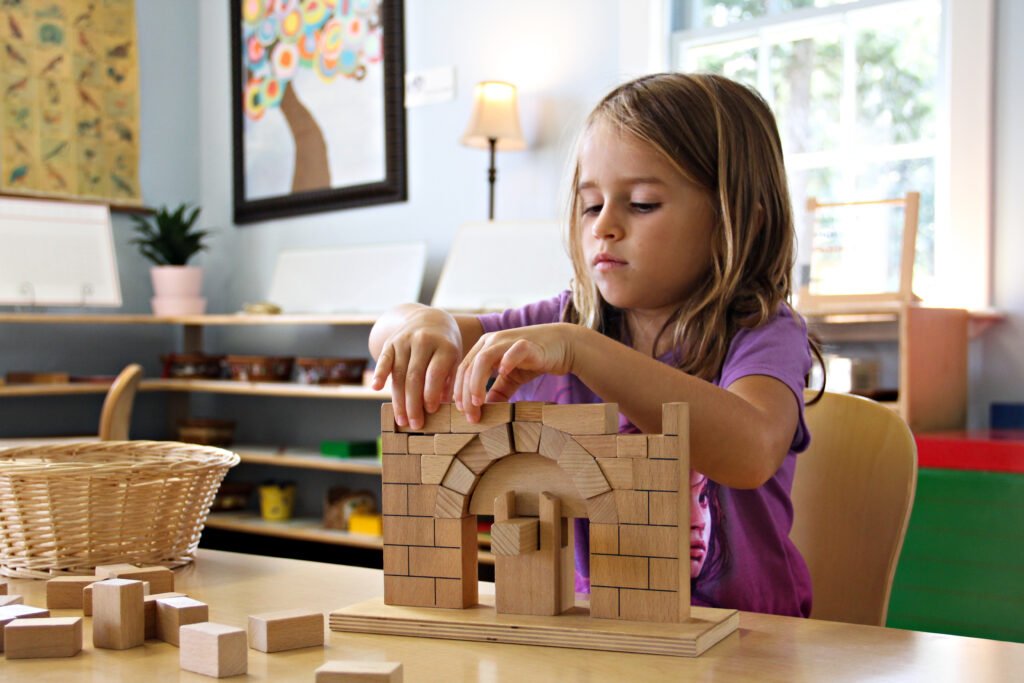
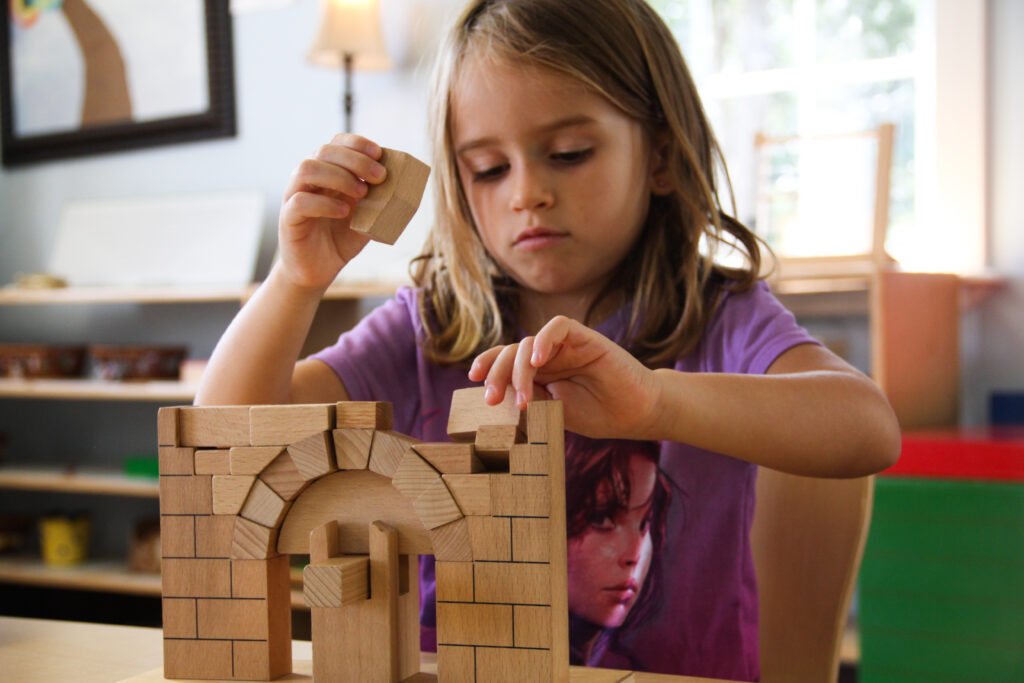
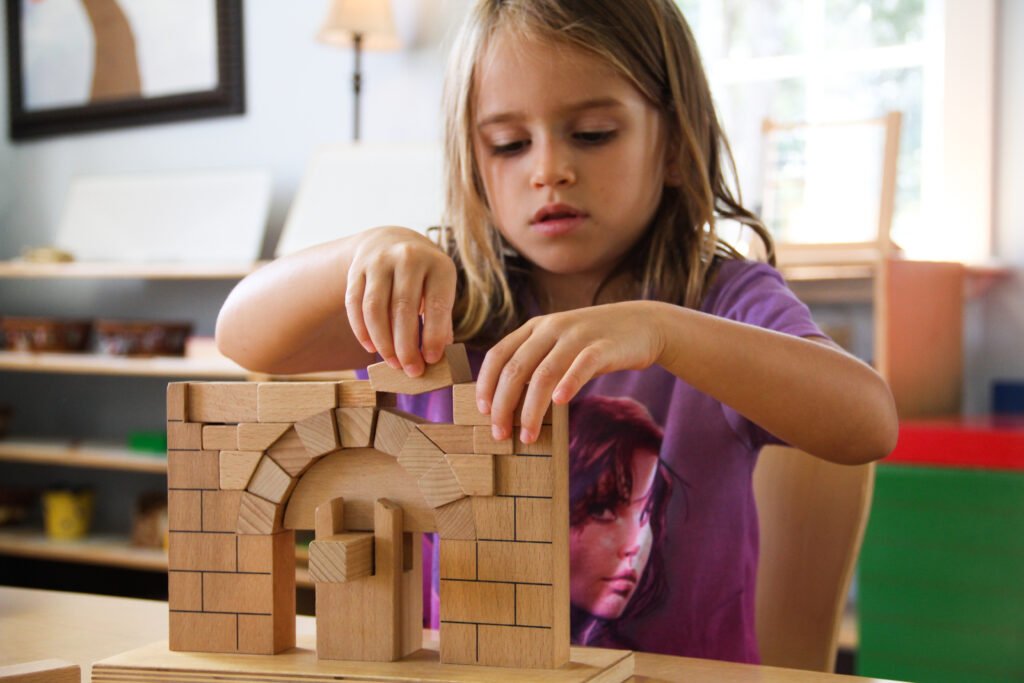

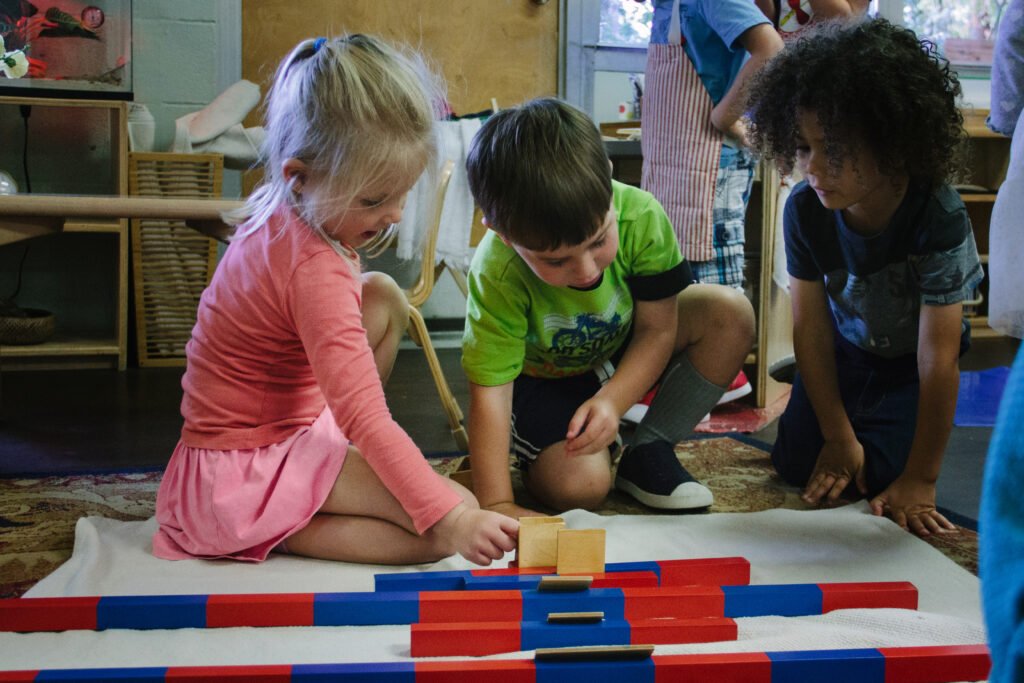
 There is great freedom given to the children in each environment, with the primary limitation on their freedom being the other humans who share their space. Think of the materials in the classroom. With the exception of a few materials there is only one of everything. This means that there will definitely be times when children want to do something that is not available.The child walks over to choose something only to discover that their classmate is working with the material. Through this the child learns to wait, take turns, exercise patience and practice delayed gratification. Self-control is born of being part of a group. Not out of depravity does the child learn these things but out of an understanding of community.
There is great freedom given to the children in each environment, with the primary limitation on their freedom being the other humans who share their space. Think of the materials in the classroom. With the exception of a few materials there is only one of everything. This means that there will definitely be times when children want to do something that is not available.The child walks over to choose something only to discover that their classmate is working with the material. Through this the child learns to wait, take turns, exercise patience and practice delayed gratification. Self-control is born of being part of a group. Not out of depravity does the child learn these things but out of an understanding of community.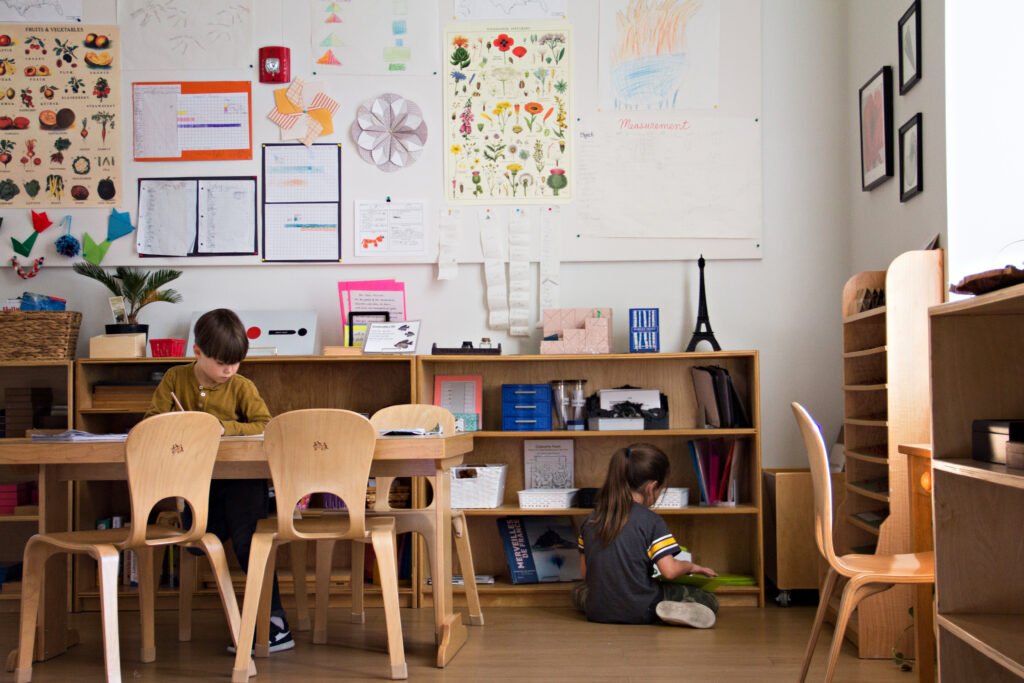 Children have the freedom to move in the classroom but their movements may not hurt others and may not disturb others' work. Their freedom is curbed in so far as they are part of a group. Individual allowances are made - children can understand why their classmate needs extra space at a table to do their giant long division problem. In fact, such allowances are easier to make because children know what it means to share space, to give and to take.How powerful to realize that our individual freedoms and choices must exist within the context of other people - that we cannot choose without our choices impacting others. The fierce individuality that Montessori environments foster through choice is misunderstood if not contextualized with the deep reverence given to interdependence and community.
Children have the freedom to move in the classroom but their movements may not hurt others and may not disturb others' work. Their freedom is curbed in so far as they are part of a group. Individual allowances are made - children can understand why their classmate needs extra space at a table to do their giant long division problem. In fact, such allowances are easier to make because children know what it means to share space, to give and to take.How powerful to realize that our individual freedoms and choices must exist within the context of other people - that we cannot choose without our choices impacting others. The fierce individuality that Montessori environments foster through choice is misunderstood if not contextualized with the deep reverence given to interdependence and community.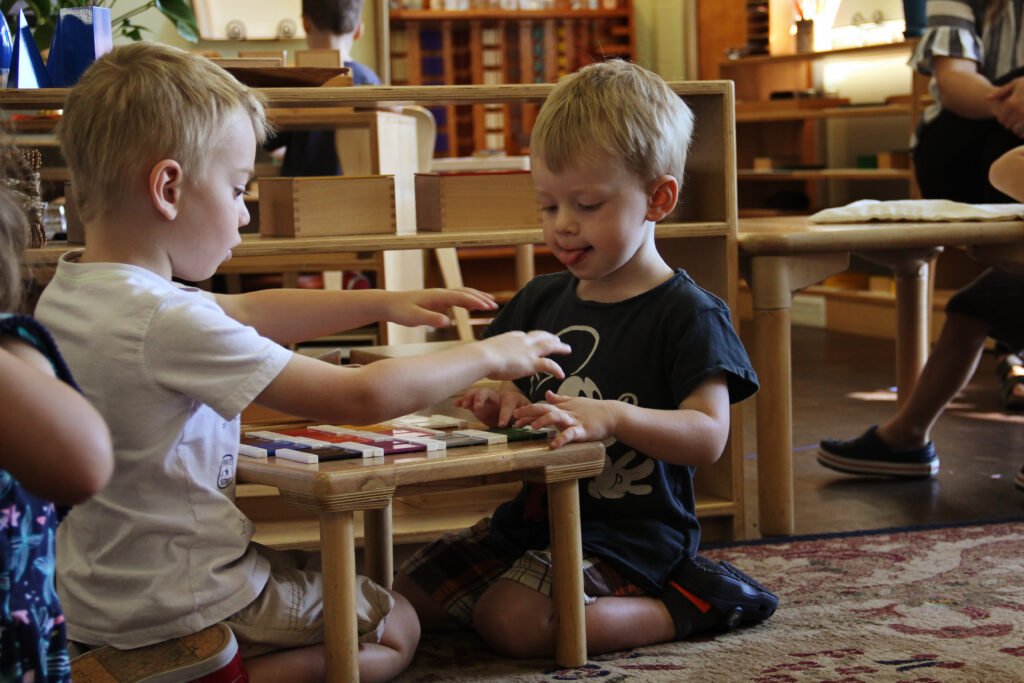 The ever talented Melinda Smith generously shared her superb photography skills once again. Melinda you are wonderful. Thank you.
The ever talented Melinda Smith generously shared her superb photography skills once again. Melinda you are wonderful. Thank you.
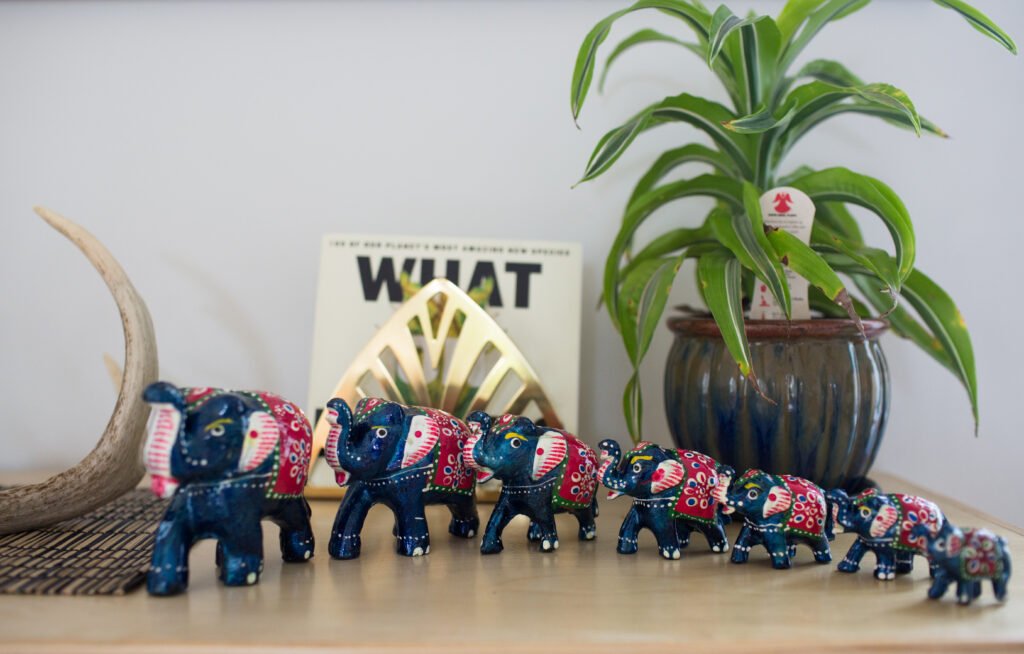 Making choices is a huge part of adult life. Our days are packed with choices, big and small. While many of us may wish to rid ourselves of the seemingly endless decision making, we can't deny that it's a central part of life - and that being good at it is advantageous.To help our children cultivate their choice making competency, we must offer choices within a framework. As wonderful as choice is in a young life, unchecked, unlimited choice hinders children's ability to choose and learn the nuances of making a choice. Limits are crucial. So, let's look into some of the parameters we can implement around choices.
Making choices is a huge part of adult life. Our days are packed with choices, big and small. While many of us may wish to rid ourselves of the seemingly endless decision making, we can't deny that it's a central part of life - and that being good at it is advantageous.To help our children cultivate their choice making competency, we must offer choices within a framework. As wonderful as choice is in a young life, unchecked, unlimited choice hinders children's ability to choose and learn the nuances of making a choice. Limits are crucial. So, let's look into some of the parameters we can implement around choices.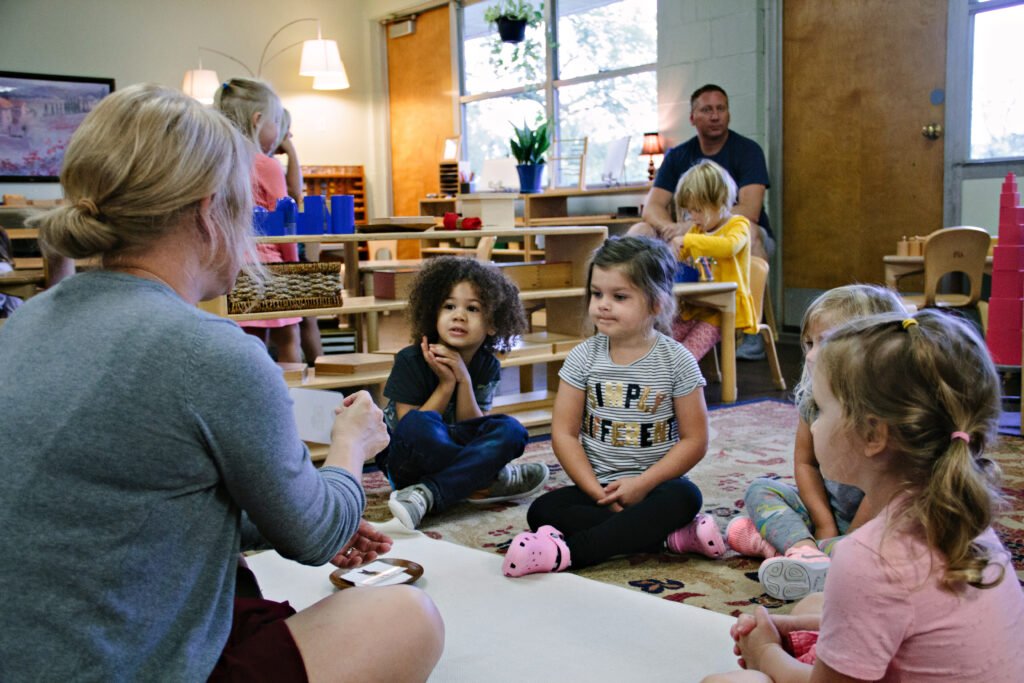 1. The first limit on choices is to remember that some things are not choices. Whether or not your child is buckled into the car before driving is not an option. Don’t offer choices that are not choices. Read more on offering real choices
1. The first limit on choices is to remember that some things are not choices. Whether or not your child is buckled into the car before driving is not an option. Don’t offer choices that are not choices. Read more on offering real choices 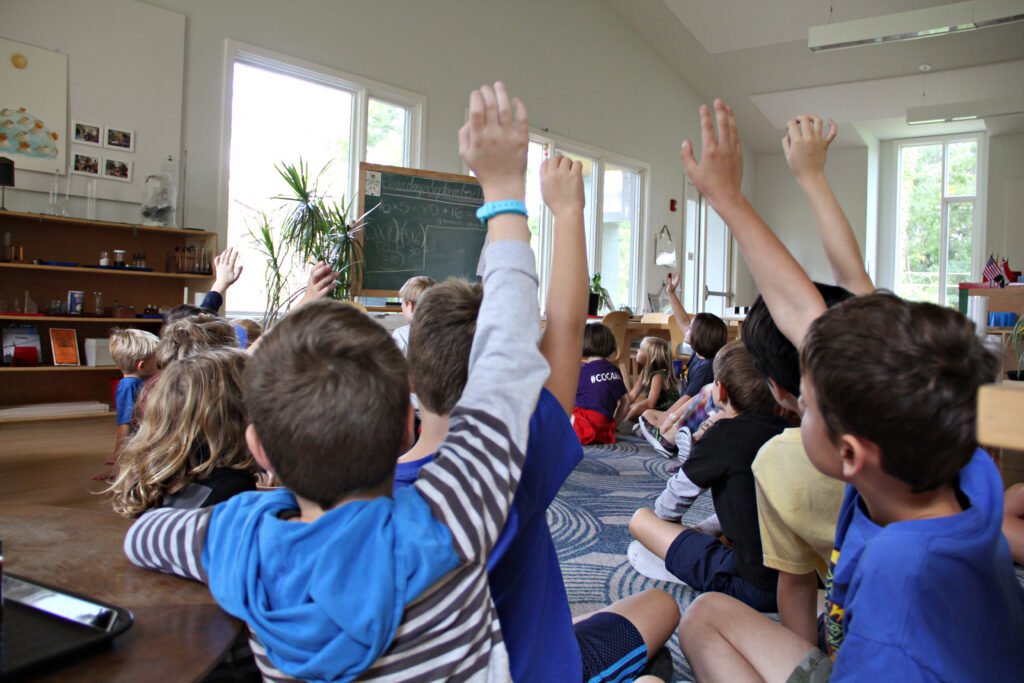 4. Only offer children low stakes choices. They need to practice making choices; they don't need to practice recovering from catastrophic choices. Children cannot always predict the entirety of the outcomes of their choices before making them - don’t offer choices that the children will be sorry they made or won't be able to recover from.5. Don’t offer a choice that consists of a terrible option vs. a great option. Generally when we do this to our children, we are really trying to make them choose one thing over another. This is not fair to your child. They are practicing making choices, let them practice.
4. Only offer children low stakes choices. They need to practice making choices; they don't need to practice recovering from catastrophic choices. Children cannot always predict the entirety of the outcomes of their choices before making them - don’t offer choices that the children will be sorry they made or won't be able to recover from.5. Don’t offer a choice that consists of a terrible option vs. a great option. Generally when we do this to our children, we are really trying to make them choose one thing over another. This is not fair to your child. They are practicing making choices, let them practice.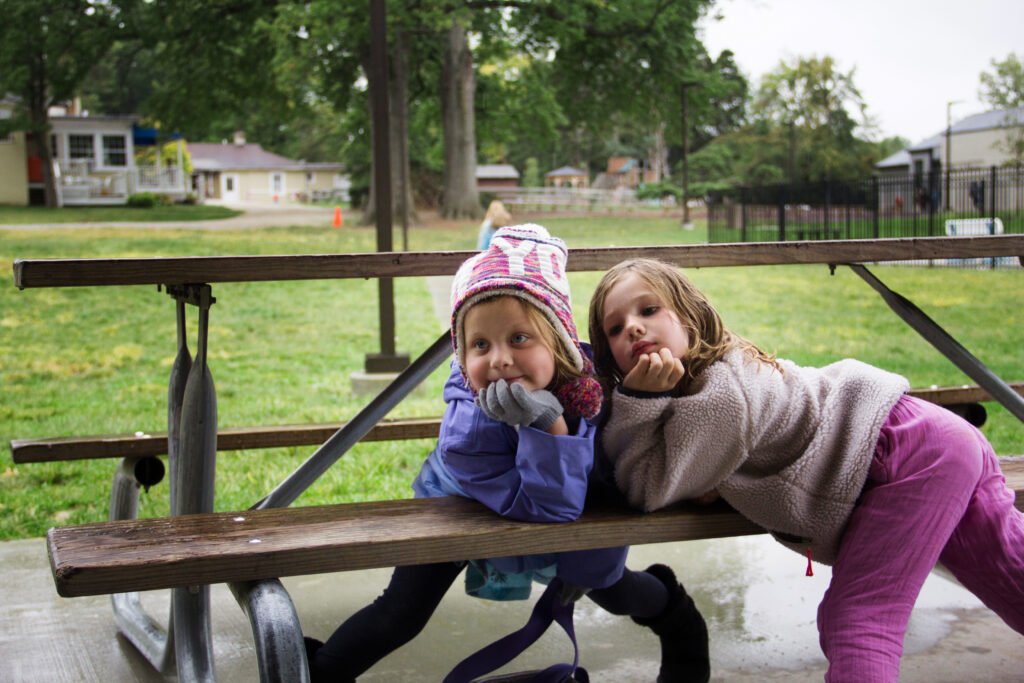 Again, seek help from someone who excels at this. Reach out to a guide or one of the many folks here to support us as parents. The nuances of choices are important and the payoff is well worth the effort!Melinda, your photos make everything better! Thank you.Thanks as well to Brigid Jhee and Anna Schwind for ideas, examples and conversations that improved this post.
Again, seek help from someone who excels at this. Reach out to a guide or one of the many folks here to support us as parents. The nuances of choices are important and the payoff is well worth the effort!Melinda, your photos make everything better! Thank you.Thanks as well to Brigid Jhee and Anna Schwind for ideas, examples and conversations that improved this post.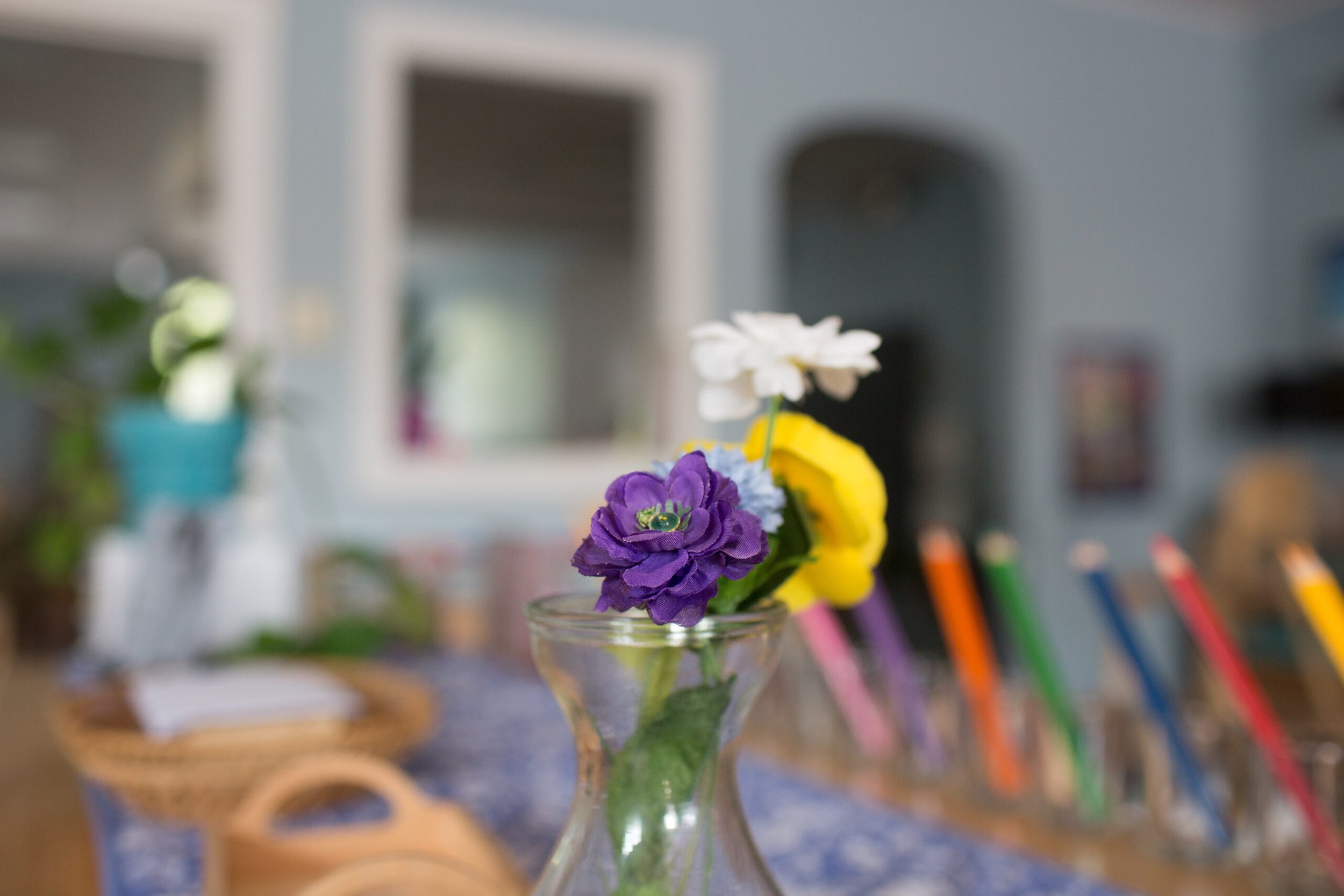
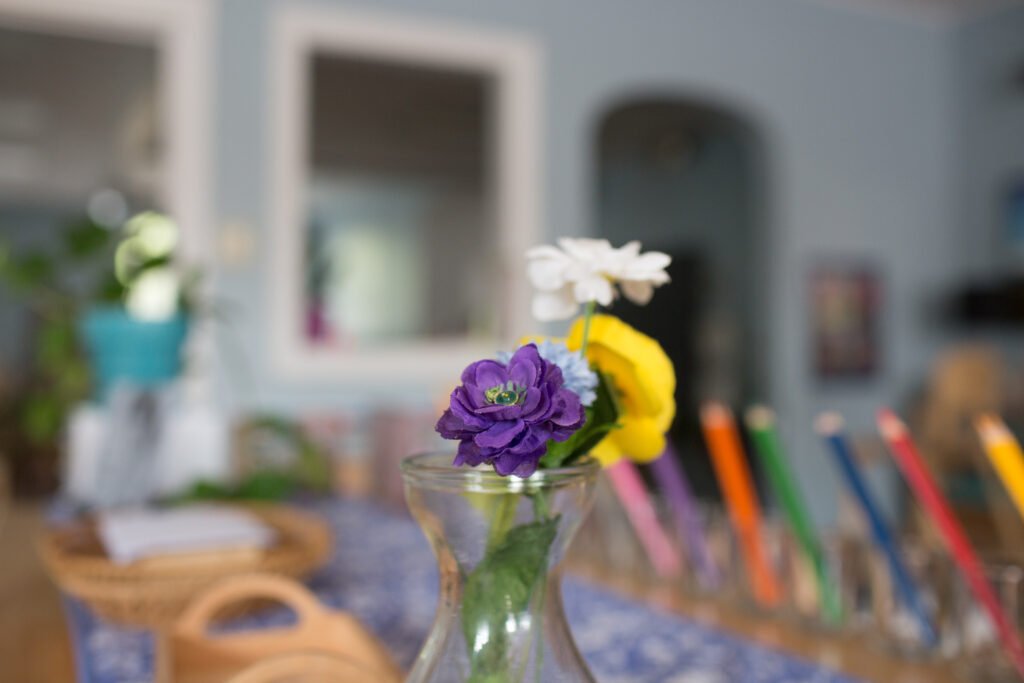 Choice is integral to Montessori because it is a necessary component of respecting the child. Choice is empowering and important. Choice allows all of us, children included, to take ownership of ourselves and our environment. We often expect children to control themselves and make good choices, but we don’t give them the opportunity to practice either of these. If you want your child to learn to control their body, you must first allow them to move their body. If you want them to make good choices, you must give them practice making choices.However, all choice is not equal. In order to reap the benefits of making a choice there are elements which must also be in play. One of these is the authenticity of the choice.
Choice is integral to Montessori because it is a necessary component of respecting the child. Choice is empowering and important. Choice allows all of us, children included, to take ownership of ourselves and our environment. We often expect children to control themselves and make good choices, but we don’t give them the opportunity to practice either of these. If you want your child to learn to control their body, you must first allow them to move their body. If you want them to make good choices, you must give them practice making choices.However, all choice is not equal. In order to reap the benefits of making a choice there are elements which must also be in play. One of these is the authenticity of the choice.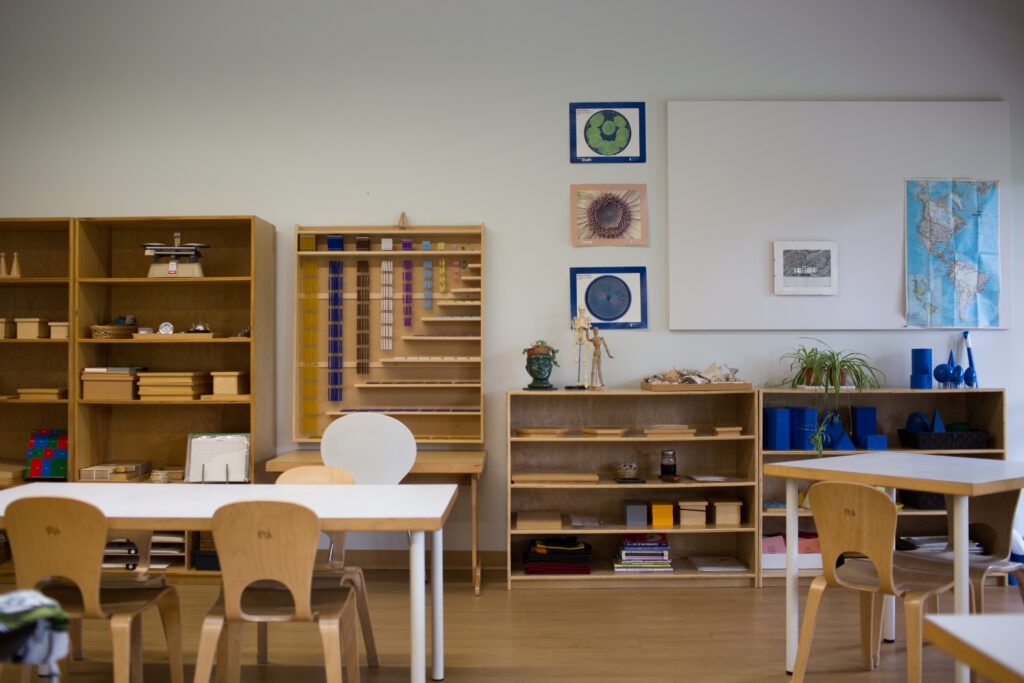 Often the choices we offer children are not real choices. I would guess we’ve all had moments where we’ve said something to the effect of, “If you don’t put on your shoes, you can’t go to school.” And, if we’re honest with ourselves we know that those words are not accurate; that choice is not real. When our child chooses not to put on their shoes, we will likely just pop those shoes on their feet and scamper off to school. Or perhaps we’ll take the negotiation route change our tack to, "I'll tell you what, if you put your shoes on you can ...."An authentic choice in the above situation would be, “Are you going to put on your shoes or shall I put them on?” Or, "Are you going to put on your left shoe first or your right shoe?" (The second approach may require a follow up of, "I see you are not choosing which shoe to put on first. I will put your left shoe on first.")Even if we think of it as practice, in order for our children to reap the vast benefits of choice-making, real choices are necessary. If a child is offered false choices (or "choices" that aren't really choices), they learn that their choice is neither important nor valid. Furthermore, they do not learn the consequences (good or bad!) of making that choice.
Often the choices we offer children are not real choices. I would guess we’ve all had moments where we’ve said something to the effect of, “If you don’t put on your shoes, you can’t go to school.” And, if we’re honest with ourselves we know that those words are not accurate; that choice is not real. When our child chooses not to put on their shoes, we will likely just pop those shoes on their feet and scamper off to school. Or perhaps we’ll take the negotiation route change our tack to, "I'll tell you what, if you put your shoes on you can ...."An authentic choice in the above situation would be, “Are you going to put on your shoes or shall I put them on?” Or, "Are you going to put on your left shoe first or your right shoe?" (The second approach may require a follow up of, "I see you are not choosing which shoe to put on first. I will put your left shoe on first.")Even if we think of it as practice, in order for our children to reap the vast benefits of choice-making, real choices are necessary. If a child is offered false choices (or "choices" that aren't really choices), they learn that their choice is neither important nor valid. Furthermore, they do not learn the consequences (good or bad!) of making that choice.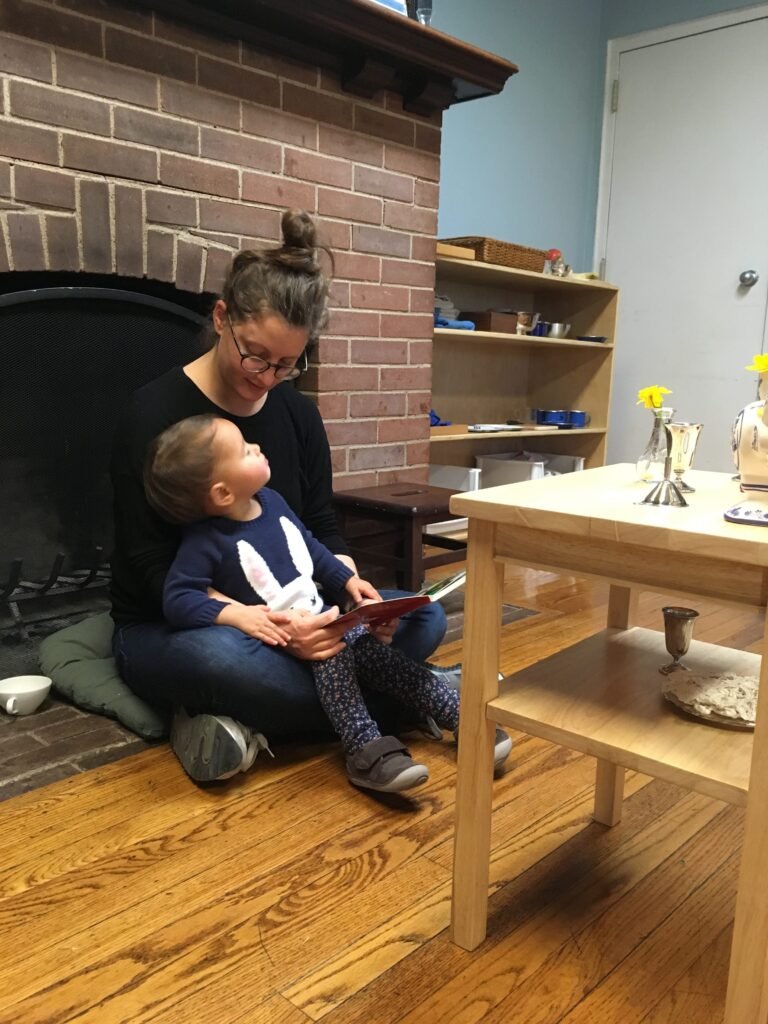 Perhaps more profoundly in the parent-child relationship, false choices do not build trust and they do not help our children understand their world. If we tell our children one thing but then do something else entirely, how do our children know what we mean? How do they know that the next time we really mean x or y? When offering a choice try your best to mean what you say and say what you mean. Yes, this is a skill that takes practice!If we offer a choice we should try to make it a genuine choice. The trust built on knowing that we mean what we say has a far-reaching effect for our children. It gives them a firm foundation on which to explore the world. It lets them see the power of their choices and their actions. The boundaries and limitations which are inherent to real choices offer a security and consistency which nurture children's growth.Choice-making, specifically learning how to make good choices, is a learned skill. It takes time to hone this skill, which is why we seek to provide lots of opportunities for practice. Try to take the time to reflect on what you're saying to your child, making sure you are offering a real choice. You give a great gift when you allow your child to truly practice making choices.With thanks to Melinda Smith and Rebecca Lev for the photographs.
Perhaps more profoundly in the parent-child relationship, false choices do not build trust and they do not help our children understand their world. If we tell our children one thing but then do something else entirely, how do our children know what we mean? How do they know that the next time we really mean x or y? When offering a choice try your best to mean what you say and say what you mean. Yes, this is a skill that takes practice!If we offer a choice we should try to make it a genuine choice. The trust built on knowing that we mean what we say has a far-reaching effect for our children. It gives them a firm foundation on which to explore the world. It lets them see the power of their choices and their actions. The boundaries and limitations which are inherent to real choices offer a security and consistency which nurture children's growth.Choice-making, specifically learning how to make good choices, is a learned skill. It takes time to hone this skill, which is why we seek to provide lots of opportunities for practice. Try to take the time to reflect on what you're saying to your child, making sure you are offering a real choice. You give a great gift when you allow your child to truly practice making choices.With thanks to Melinda Smith and Rebecca Lev for the photographs.
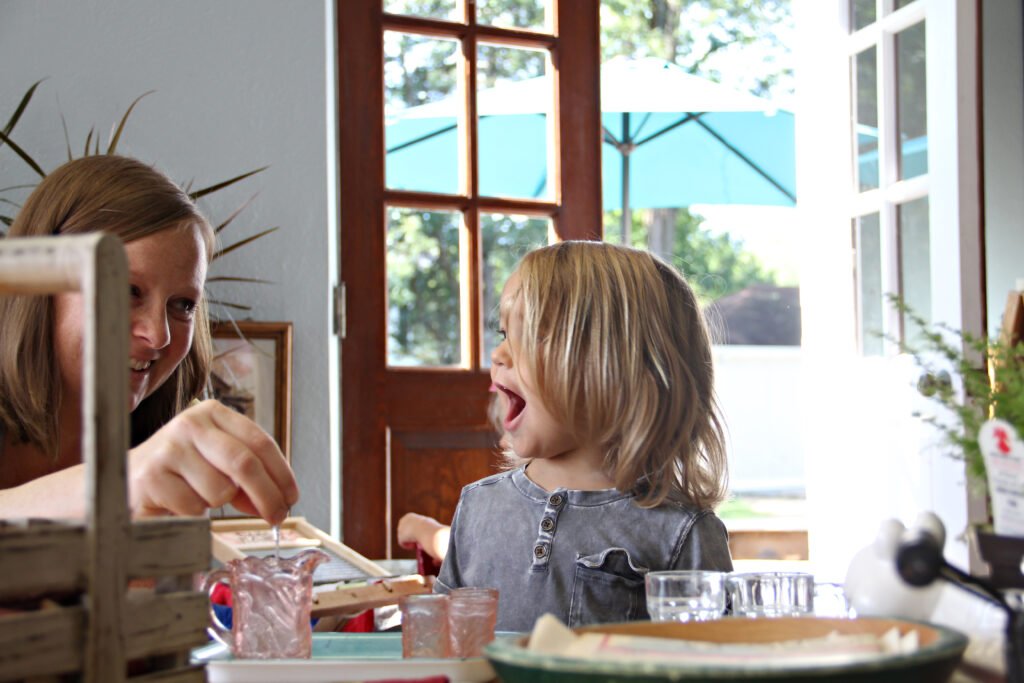
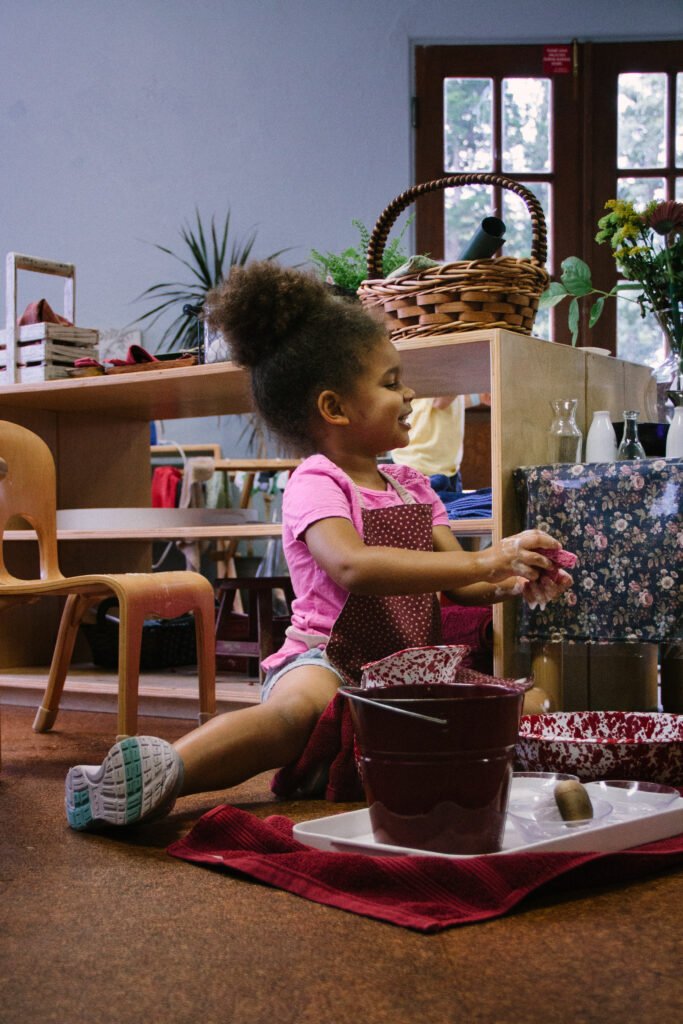
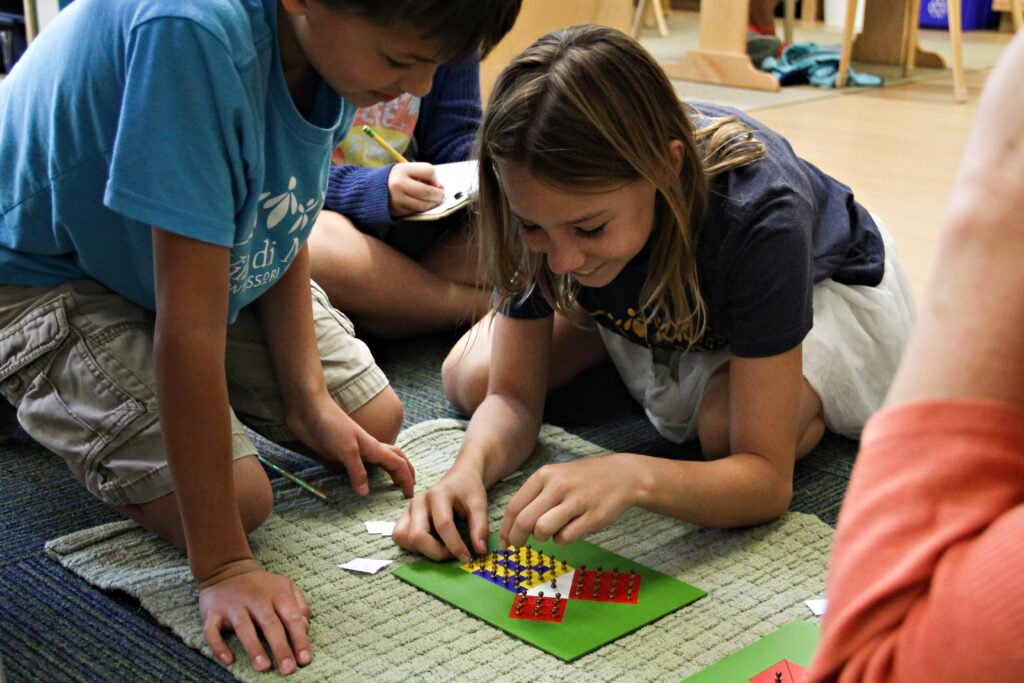
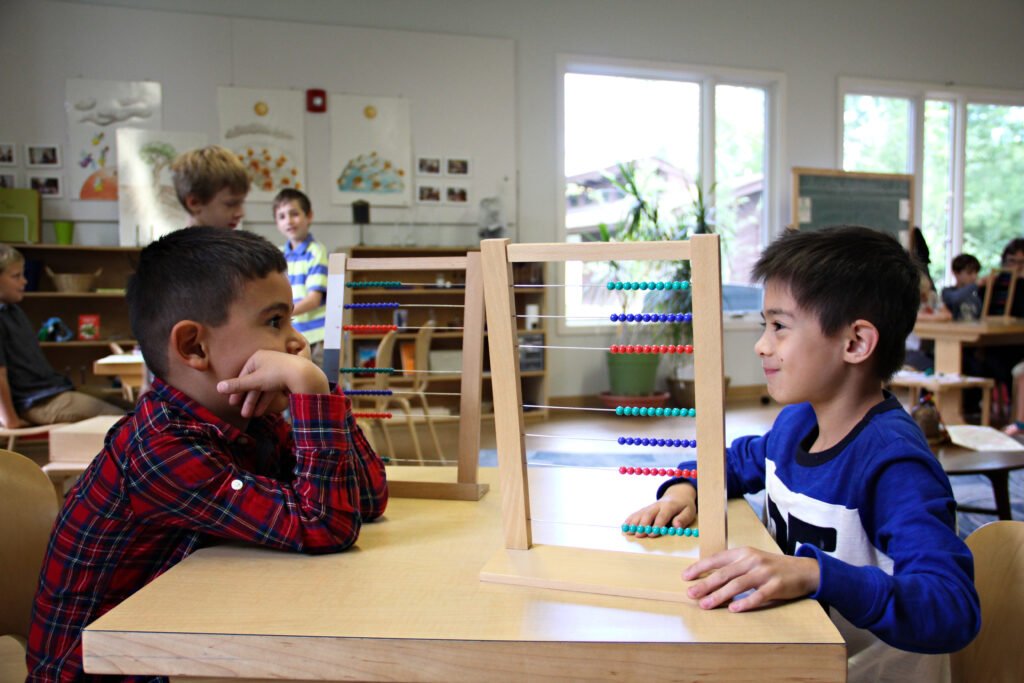

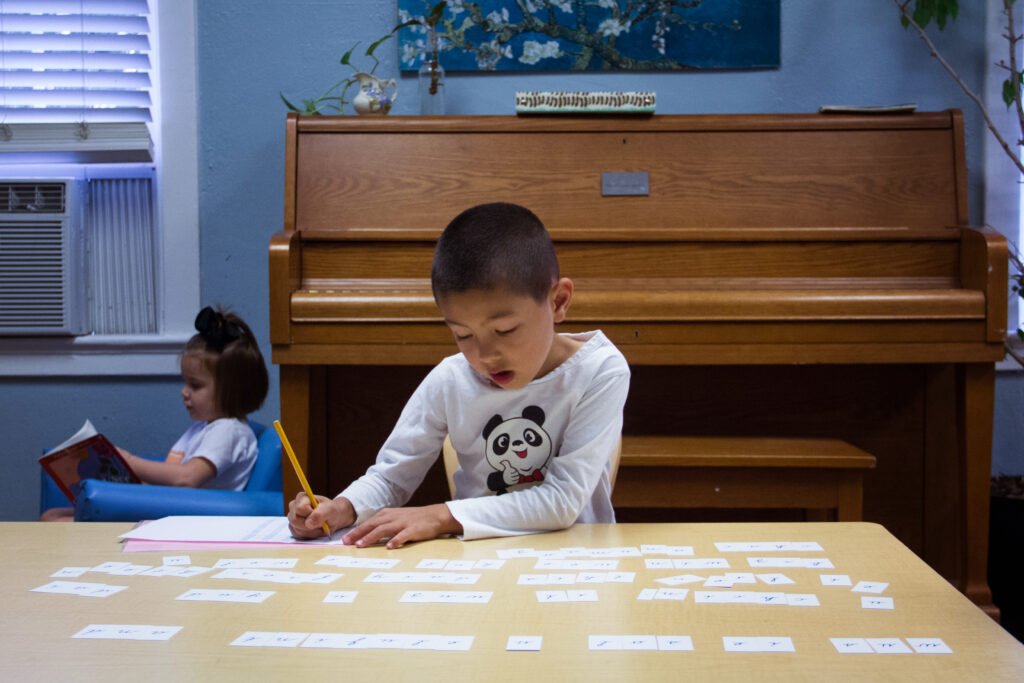 How brilliant to succeed at something that seemed just out of reach, but that we then find attainable through purposeful work. This is the Montessori environment. The happiness of the children in the classroom is the happiness of work, the joy of learning.
How brilliant to succeed at something that seemed just out of reach, but that we then find attainable through purposeful work. This is the Montessori environment. The happiness of the children in the classroom is the happiness of work, the joy of learning.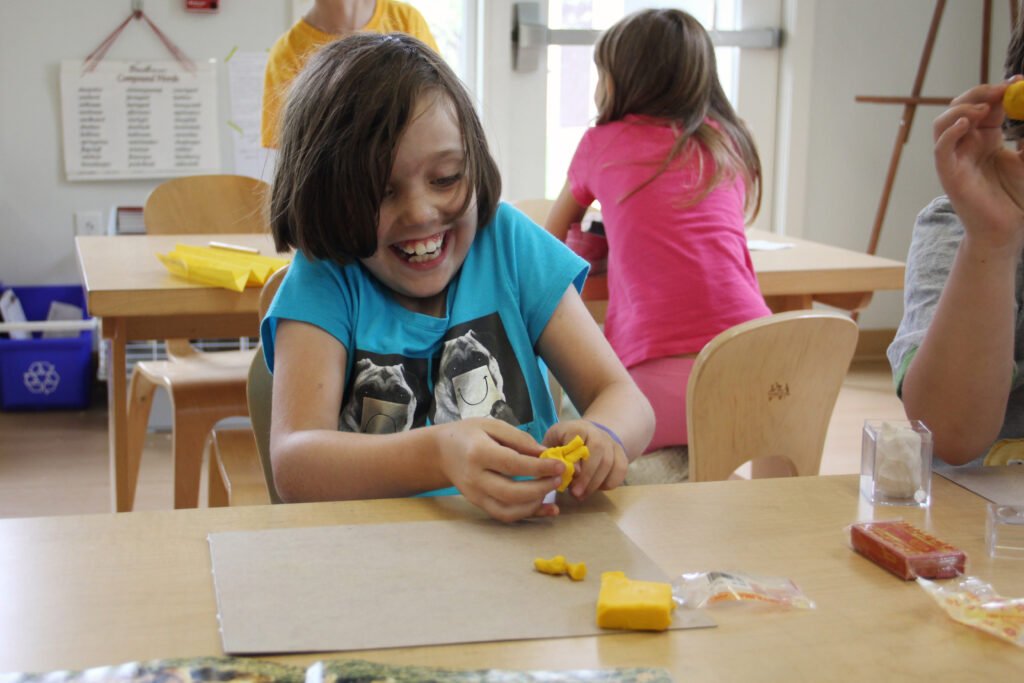 Photographic gems compliments of Melinda Smith.
Photographic gems compliments of Melinda Smith.
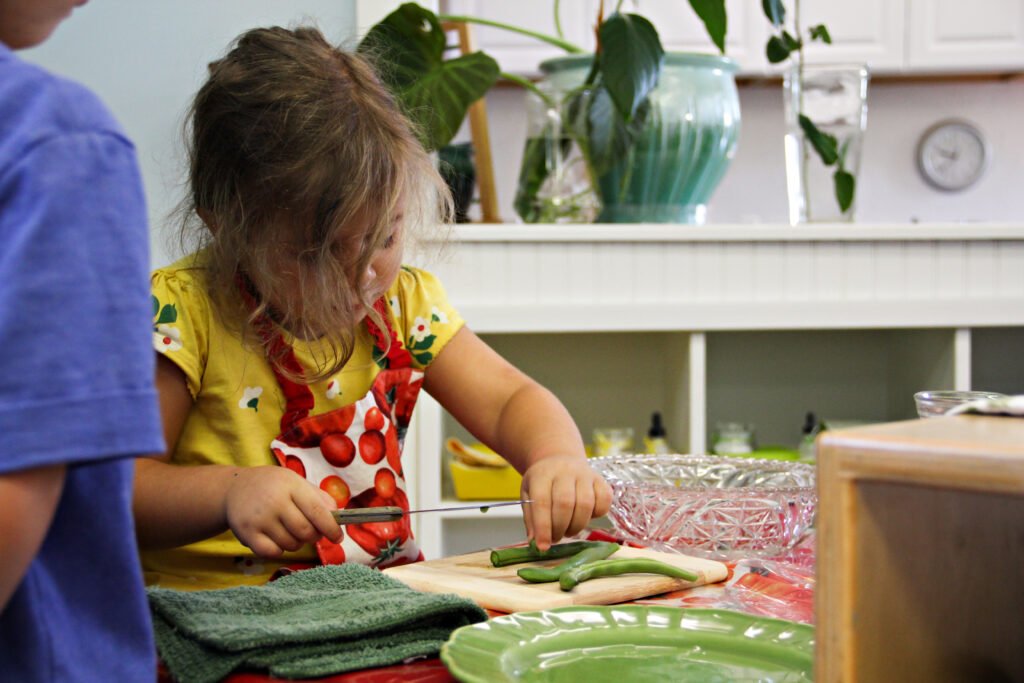 Inhibitory control can be broken down into self-control and selective attention. Self-control is a person’s ability to intentionally refrain from doing something. Selective attention is the ability to choose to focus on one thing (e.g., talking to one person at a party without being distracted by the other conversations around you).
Inhibitory control can be broken down into self-control and selective attention. Self-control is a person’s ability to intentionally refrain from doing something. Selective attention is the ability to choose to focus on one thing (e.g., talking to one person at a party without being distracted by the other conversations around you).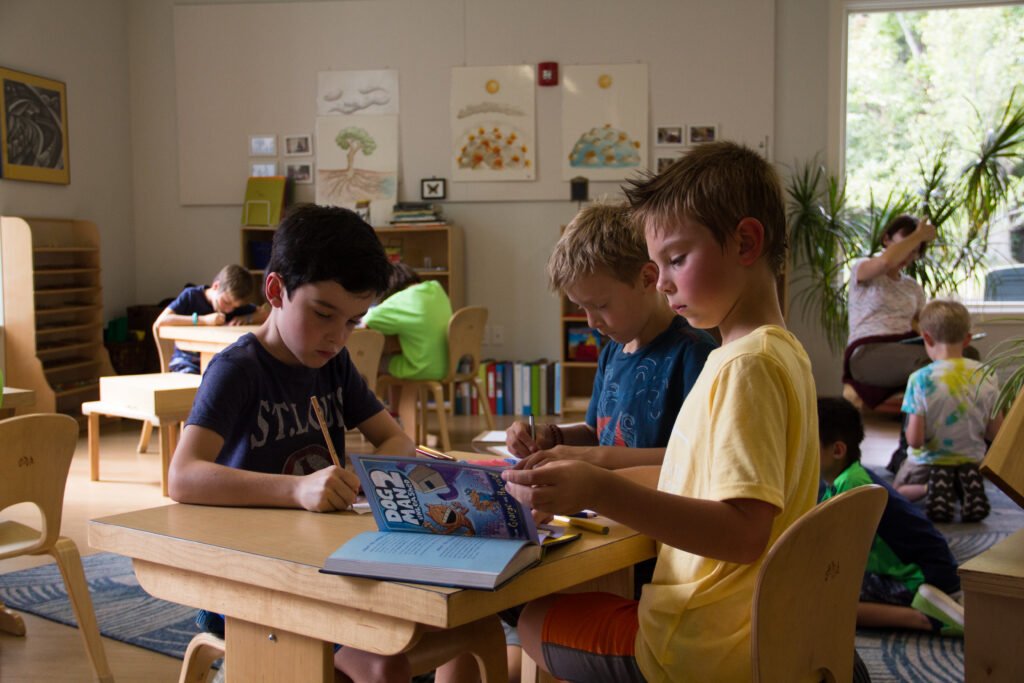
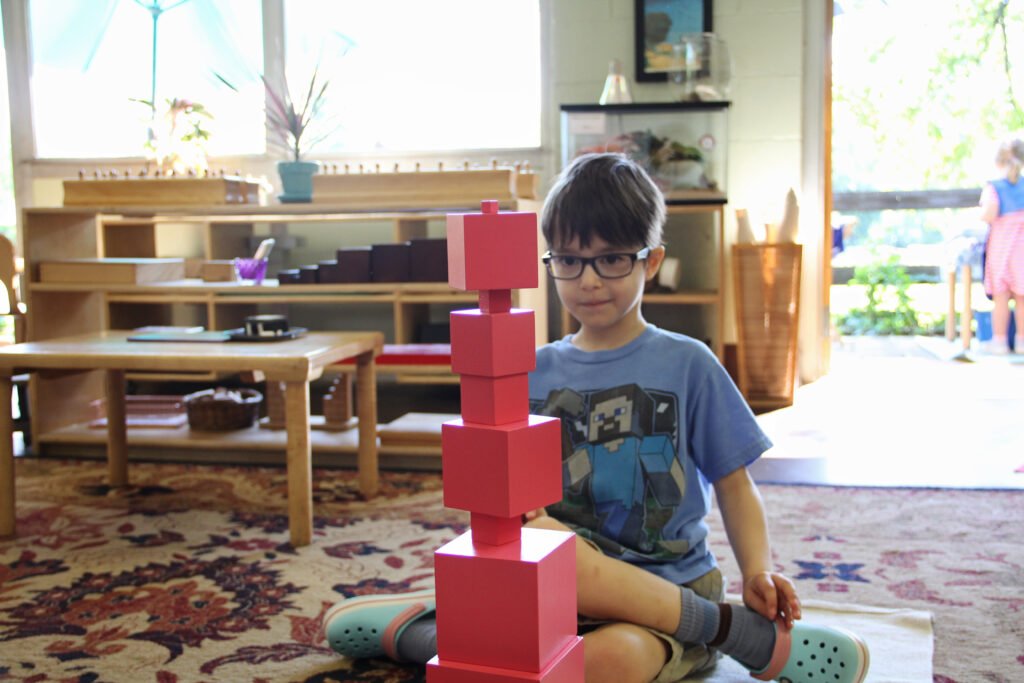 Working memory refers to holding information in your mind and doing something with it. This ability is vital for understanding change over time, following direction, reading and doing mental math.
Working memory refers to holding information in your mind and doing something with it. This ability is vital for understanding change over time, following direction, reading and doing mental math.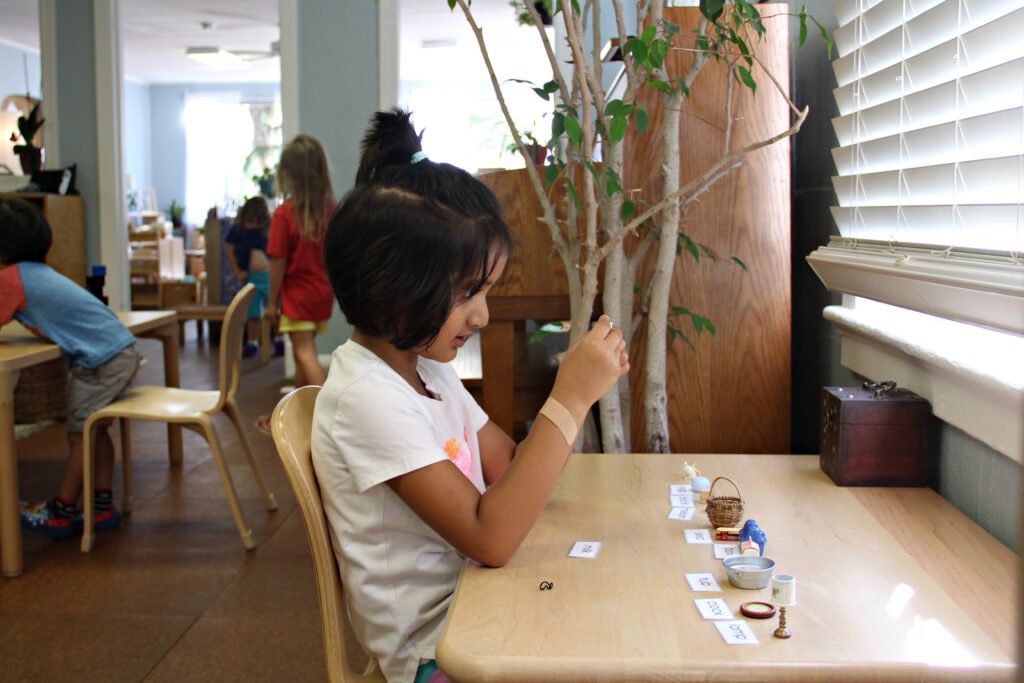 Cognitive flexibility is the ability to switch from task to task or to take in new information and reformulate your thinking based on the integration of new information (e.g., admit to making mistakes or to being mistaken!). What a great skill to have as an adult! And how we long for our children to have this ability.
Cognitive flexibility is the ability to switch from task to task or to take in new information and reformulate your thinking based on the integration of new information (e.g., admit to making mistakes or to being mistaken!). What a great skill to have as an adult! And how we long for our children to have this ability.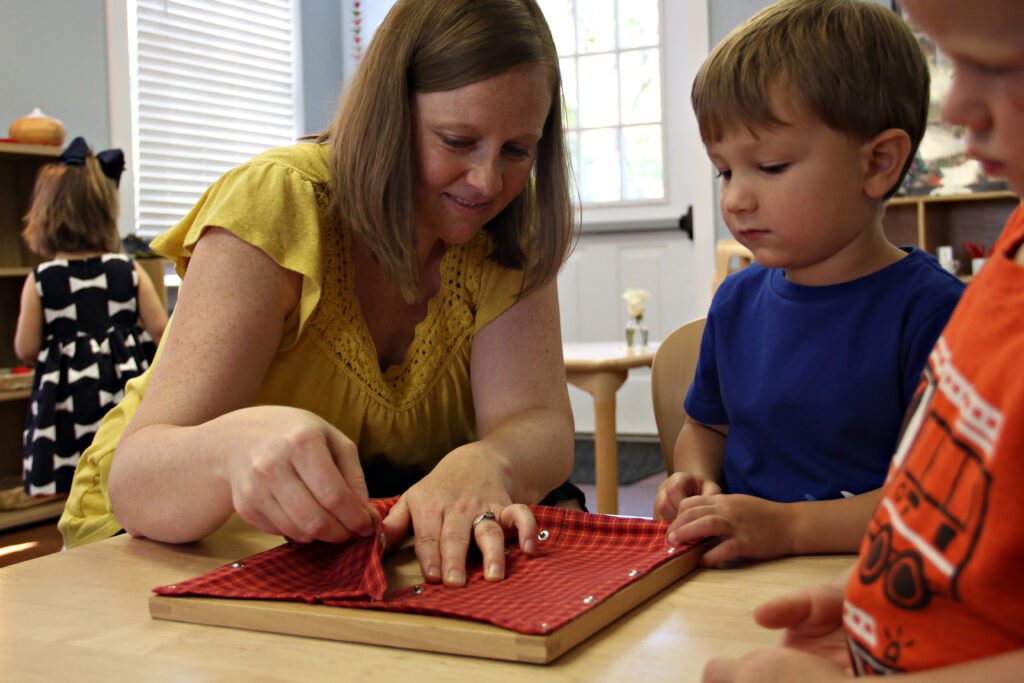
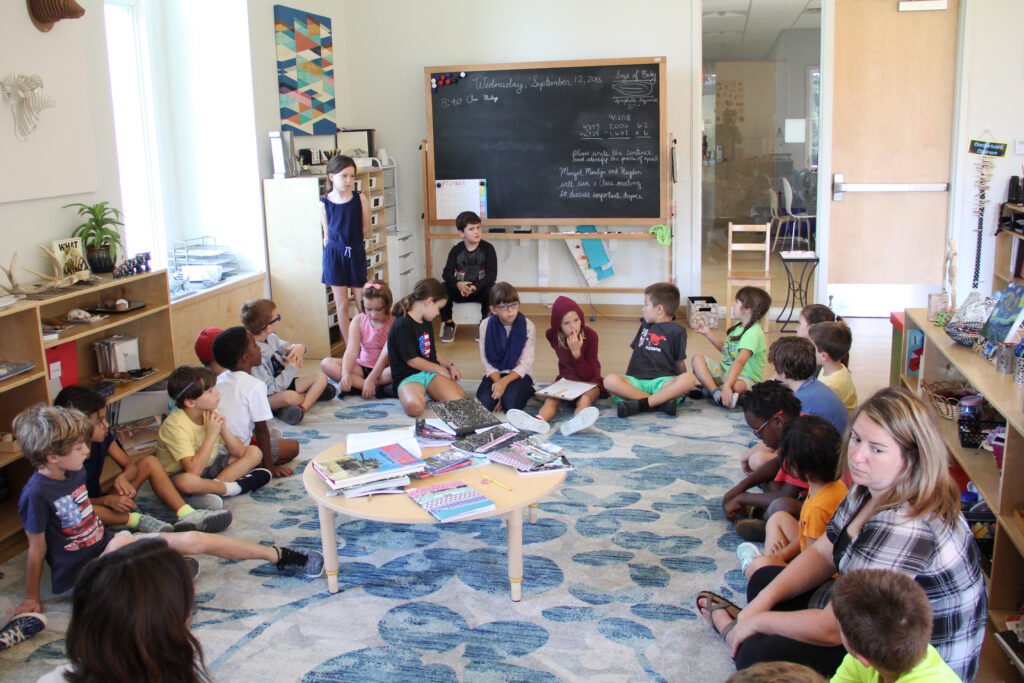 From these three core functions grow the more complex functions of problem solving, reasoning and planning. It’s easy to see why executive functions are so important not just for success in school but also in life. More to come...Bibliography:
From these three core functions grow the more complex functions of problem solving, reasoning and planning. It’s easy to see why executive functions are so important not just for success in school but also in life. More to come...Bibliography: 
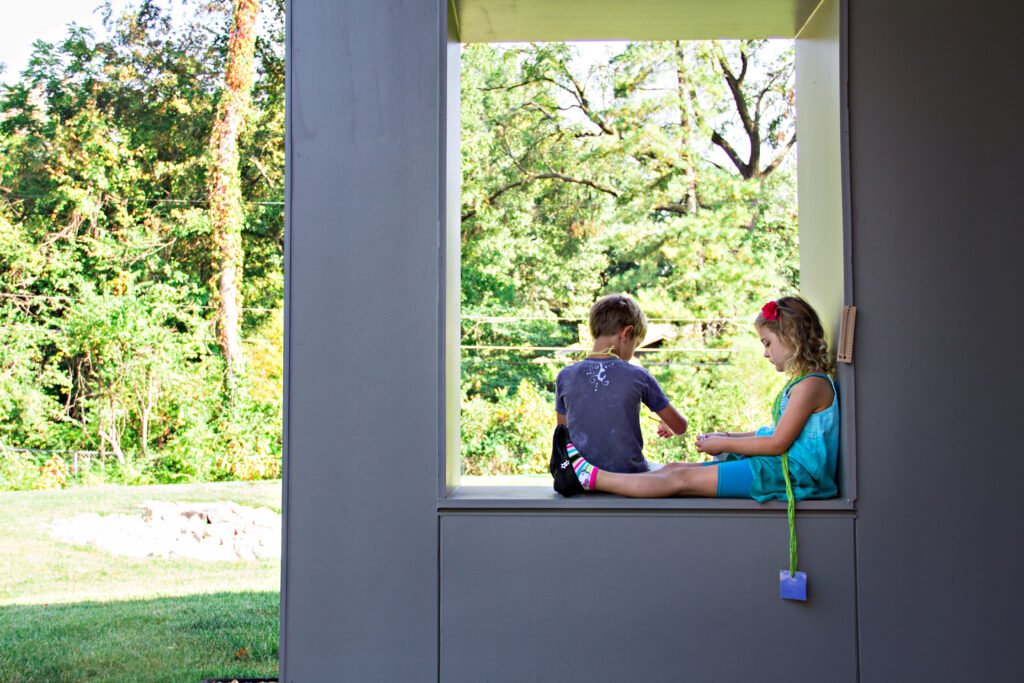
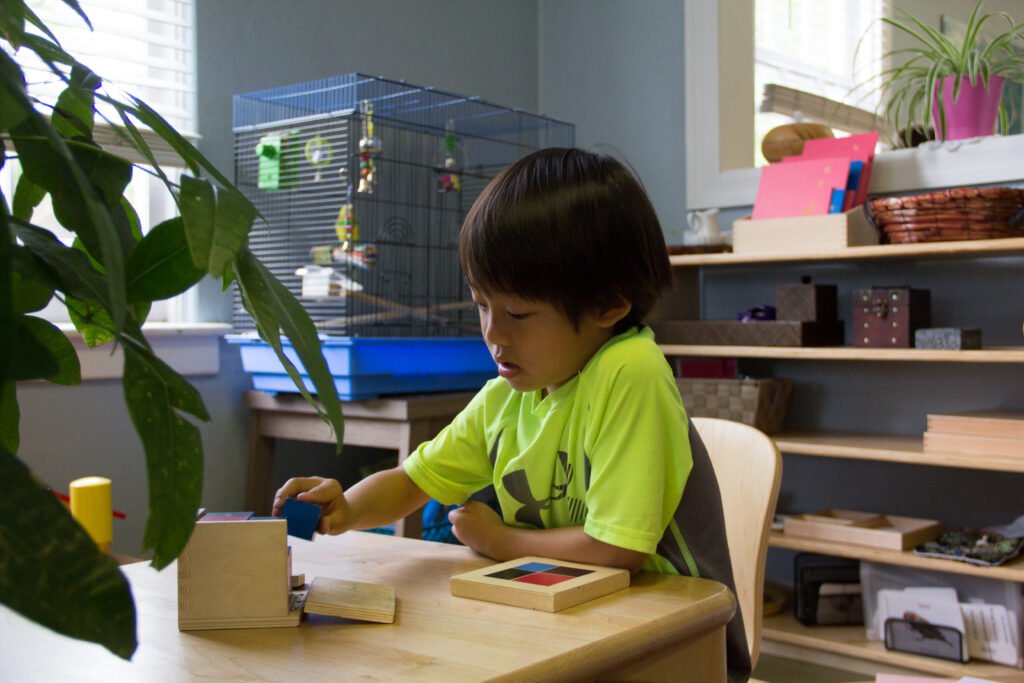 Peace begins with the self, and there are many ways in which classrooms promote calm with oneself as the starting point for a peaceful mindset. Some schools may have peace corners or labyrinths for children to use. Others may have practices of yoga, meditation or mindfulness exercises that are practiced with the children to help them experience centeredness and calm. Books about these subjects may be read to the children, or available for them to read to themselves. The classroom environments are prepared with materials that are soothing, promote serenity and enable focused work. Once the child has experienced peace, they can find it again and again. They can help others find it, too.
Peace begins with the self, and there are many ways in which classrooms promote calm with oneself as the starting point for a peaceful mindset. Some schools may have peace corners or labyrinths for children to use. Others may have practices of yoga, meditation or mindfulness exercises that are practiced with the children to help them experience centeredness and calm. Books about these subjects may be read to the children, or available for them to read to themselves. The classroom environments are prepared with materials that are soothing, promote serenity and enable focused work. Once the child has experienced peace, they can find it again and again. They can help others find it, too.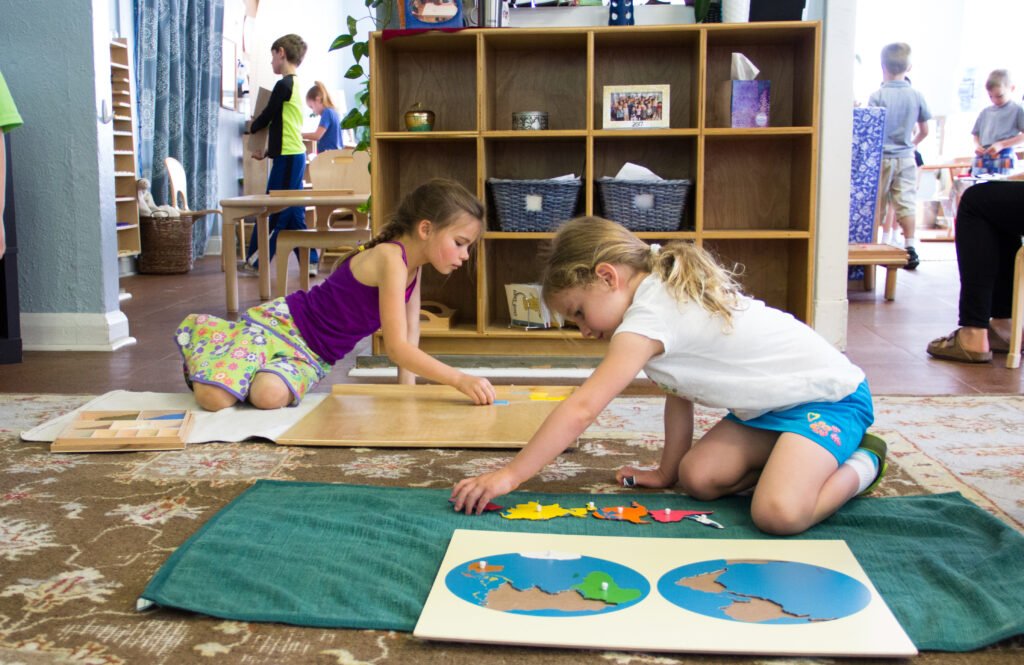 Peace is promoted through understanding others, which is why so much of the curriculum promotes knowledge and understanding of all the different places in our world and how other people come to meet the fundamental needs that all humans have. In the elementary, there are specific lessons that focus on the interrelatedness of all things, both living and non-living. We need others, and we need our planet and thus we must find harmonious ways to co-exist with all.
Peace is promoted through understanding others, which is why so much of the curriculum promotes knowledge and understanding of all the different places in our world and how other people come to meet the fundamental needs that all humans have. In the elementary, there are specific lessons that focus on the interrelatedness of all things, both living and non-living. We need others, and we need our planet and thus we must find harmonious ways to co-exist with all.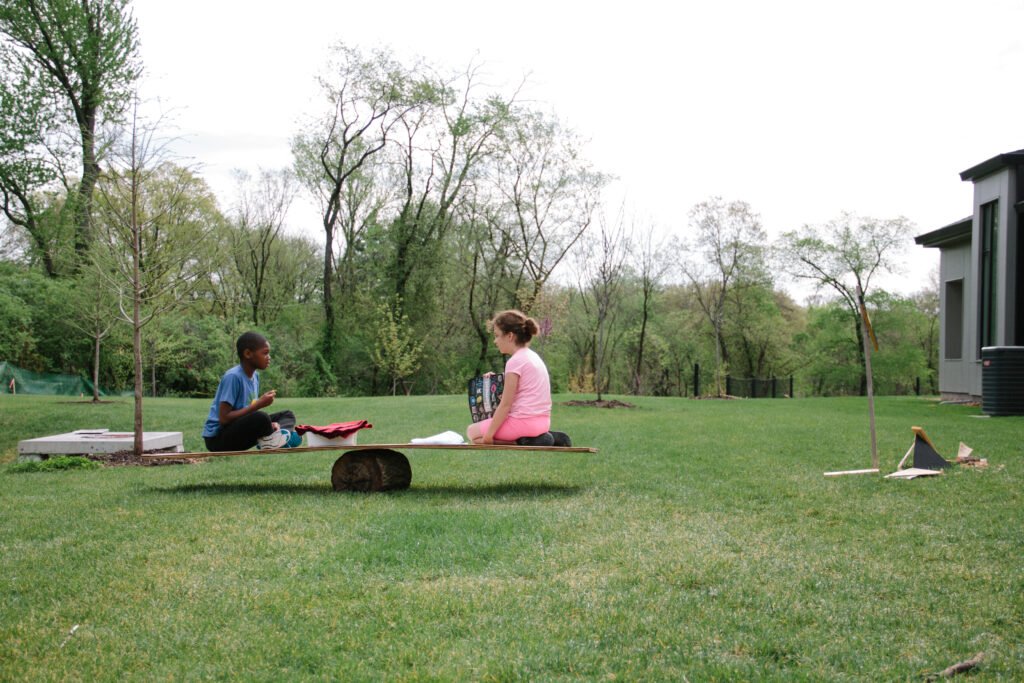 Peace is also promoted through years and years of modeling positive conflict resolution in peer interactions on a daily basis. The idea that we can come to solutions by talking about the problem and taking positive collaborative actions is given over and over. Children follow this process with guides and assistants as often as necessary. Ultimately they become able to lead this process themselves. Little is more rewarding than watching an older child step into the role of mediator, and watching a conflict dissolve as they patiently work through the details of it with each person involved. This daily experience culminates when the oldest children from VdM participate in the Montessori Model United Nations (MMUN), which is a remarkable life experience meant to model cooperative problem solving and mediation on a national scale, country to country. What they have practiced as individuals for so many years now comes into play on a much larger scale. And once they have known that problems can be solved without violence or aggression, and that mutually beneficial solutions can almost always be found with persistence, then they are ready to go into the world and solve problems peacefully.
Peace is also promoted through years and years of modeling positive conflict resolution in peer interactions on a daily basis. The idea that we can come to solutions by talking about the problem and taking positive collaborative actions is given over and over. Children follow this process with guides and assistants as often as necessary. Ultimately they become able to lead this process themselves. Little is more rewarding than watching an older child step into the role of mediator, and watching a conflict dissolve as they patiently work through the details of it with each person involved. This daily experience culminates when the oldest children from VdM participate in the Montessori Model United Nations (MMUN), which is a remarkable life experience meant to model cooperative problem solving and mediation on a national scale, country to country. What they have practiced as individuals for so many years now comes into play on a much larger scale. And once they have known that problems can be solved without violence or aggression, and that mutually beneficial solutions can almost always be found with persistence, then they are ready to go into the world and solve problems peacefully.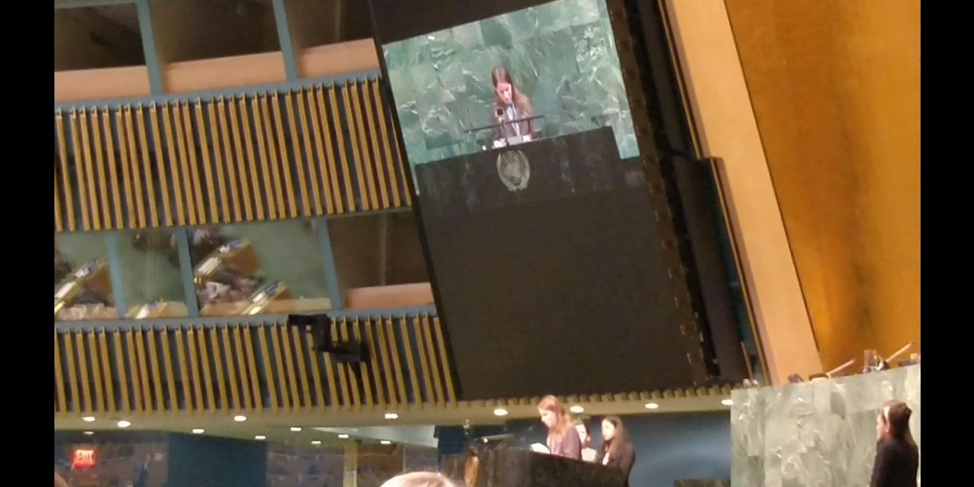 It bears saying one more time: Happy International Day of Peace!However, know that at VdM peace is the work of all the days of the year.
It bears saying one more time: Happy International Day of Peace!However, know that at VdM peace is the work of all the days of the year.